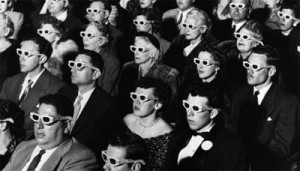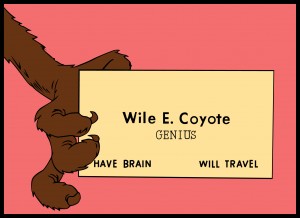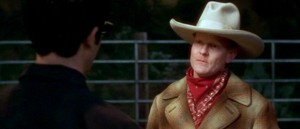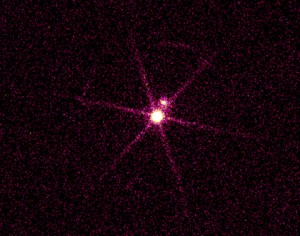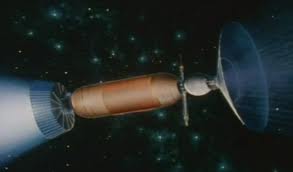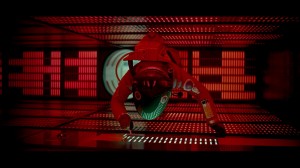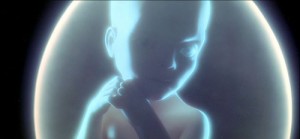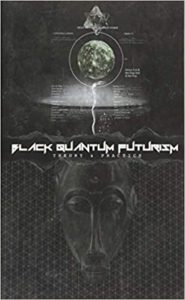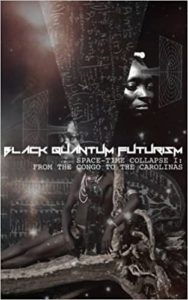The Nightshirt Sightings, Portents, Forebodings, Suspicions
To the Unified Field (via Twin Peaks): David Lynch’s Paintings
“We live in a world of opposites, of extreme evil and violence opposed to goodness and peace. It’s that way here for a reason but we have a hard time grasping what the reason is. In struggling to understand the reason, we learn about balance and there’s a mysterious door right at that balance point. We can go through that door anytime we get it together.” —David Lynch
Many fans of David Lynch’s films are probably aware that he started as a painter and has continued to work in that medium all his life. (For example, they may have glimpsed him at work in his atelier in the documentary that accompanies the Inland Empire DVD.) But it has been frustrating trying to find examples of his paintings and drawings because there has been no single book comprehensively showcasing them. Finally, David Lynch: The Unified Field, the catalogue of an exhibition at the Pennsylvania Academy of the Fine Arts, where he studied as a young man, beautifully displays this “other” side of Lynch’s creativity.
 It’s a gorgeous book, with an excellent long essay by Robert Cozzolino. It will do much to help Lynch claim the recognition he deserves as a very serious and original artist in a completely different medium from his film and TV work. I’ve spent days thumbing through it already and it is still full of delights and surprises.
It’s a gorgeous book, with an excellent long essay by Robert Cozzolino. It will do much to help Lynch claim the recognition he deserves as a very serious and original artist in a completely different medium from his film and TV work. I’ve spent days thumbing through it already and it is still full of delights and surprises.
Lynch’s paintings, which are bold, childlike and threatening, remind me of Francis Bacon crossed with a dark Cy Twombly, often integrating thickly spackled paint (he mentions feeling the urge to chew on his paintings) with text that is either ultra-banal or psychotic. They reflect many of the same themes that recur in his movies, such as the violence, madness, perverse sexuality, and even paranormal phenomena that can be found when you peel back the surface of outwardly bland American life—or, that become visible at a smaller scale, when you zoom in. But—and this is crucial—they are also often funny; there is typically a sly poke in the ribs underneath the overt threat. (This is what sets him far apart from Bacon, say.)
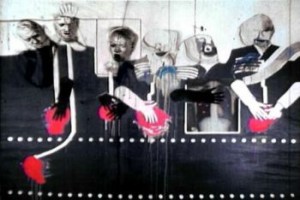 Lynch’s early “moving picture” installation, “Six Men Getting Sick” (which has been recreated for the PAFA exhibition), is like a prototype for many of his later works both in film and on canvas. Six faces imprisoned in a gray-white wall vomit repeatedly; they cannot leave the wall, cannot get up and go to the doctor or even to the toilet, but are trapped in a perpetual materialist hell, purging throughout eternity. It somewhat reminds me of HR Giger’s transhumanist visions of immobilized sentiences trapped and suffering in and from brute matter, although Lynch’s outwardly “ugly” spectacle is far more ambiguous and strange than Giger’s sleek, seductive machine-erotic futurescapes.
Lynch’s early “moving picture” installation, “Six Men Getting Sick” (which has been recreated for the PAFA exhibition), is like a prototype for many of his later works both in film and on canvas. Six faces imprisoned in a gray-white wall vomit repeatedly; they cannot leave the wall, cannot get up and go to the doctor or even to the toilet, but are trapped in a perpetual materialist hell, purging throughout eternity. It somewhat reminds me of HR Giger’s transhumanist visions of immobilized sentiences trapped and suffering in and from brute matter, although Lynch’s outwardly “ugly” spectacle is far more ambiguous and strange than Giger’s sleek, seductive machine-erotic futurescapes.
On one level, Lynch could be called a painter of matter—of vomit, dirt, muck, rust, and biological decay that step in to co-create the world after humans have contributed their part. He is quoted in the opening essay about being allowed to spend time with corpses in the Philadelphia morgue when he was in art school, and the beauty he finds in “organic processes” that he got from his time spent with his father, who was a specialist in tree diseases working for the Forest Service when he was a child in Montana. Throughout his works, abandoned factories, mud and sores, or the brown stains on the made world, all become sublime.
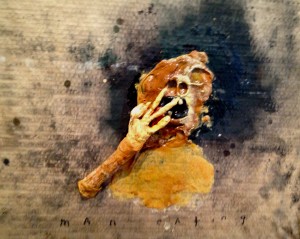 But the matter, even when or especially when it is decaying and messy, is only barely covering over something deeper (or higher). In interviews (and in his brief 2007 book Catching the Big Fish: Meditation, Consciousness, and Creativity
But the matter, even when or especially when it is decaying and messy, is only barely covering over something deeper (or higher). In interviews (and in his brief 2007 book Catching the Big Fish: Meditation, Consciousness, and Creativity), Lynch always takes the opportunity to tell people how his own youthful anger and neurosis were cured through Transcendental Meditation and that his creativity is fueled by his twice-daily practice of dipping into the fundamental wellspring he calls the “unified field.” He would thus surely not mind us using his paintings for meditation or as advertisements for the rewards of meditation. Specific altered states of perception I have experienced as a byproduct of my own Zen-influence practice help me pin down exactly what the mysterious X quality in his paintings is—the precise tension they invoke (at least in me).
Buddhist writers don’t like to dwell on the mild altered states produced by meditation, preferring that we not get attached to them, but when you detach from your environment even for very brief periods, the world can afterwards take on a funny, mysterious, alive-yet-dead quality that is full of exciting unseen potential. I have noticed for years that after meditating, the world has an altered character that feels distinctly “Lynchian”: Specifically, it feels like the world has suddenly become the world of Twin Peaks—the ordinary, mundane world, but with something added that is a mix of mysterious, humorous, ominous, and subtly exciting. This is why I was so excited to finally get a book of Lynch’s paintings—to see if they had this same quality. I was not disappointed.
One way to think of the subtly altered state of perception I’m referring to is in terms of the “imaginal” that was described by Sufi scholar Henri Corbin: a kind of transfigured surreality overlaid on or coexisting with the everyday world, shimmering in and out of existence. Objects shine funny, oddly, significantly. They wink, ever so slightly. The importance of everything, even just this ashtray or coffee table or lamp, is ever so slightly elevated because through some subtle alteration of frequency, some slight turn of the dial, the shitty bathroom or grocery store or parking lot you happen to be standing in has suddenly become the VIP section of an international spirit-world airport, where one just might encounter other enlightened beings passing through. Even pieces of garbage or dead leaves are “slightly enlightened” celebrities, and you belong in their exciting world.
 I think of this imaginal as a dangerous-feeling and uncomfortable perimeter or no-man’s land that surrounds the blissful Void or Absolute (or “unified field”) that all forms of meditation and mysticism aim for. The ultimate aim is not to linger in this perimeter zone, but you do need to pass through it—and the passage can be really enjoyable and interesting in its own right. This book of paintings confirms for me that Lynch, through his meditation practice, knows about this imaginal no-man’s land and that this is specifically what he is trying to show to us (because the unified field itself can’t be shown). Anything can happen, is about to happen, in this zone, and it pays to be fully awake and alert to the enhanced potential even in the most inanimate of objects and phenomena in it.
I think of this imaginal as a dangerous-feeling and uncomfortable perimeter or no-man’s land that surrounds the blissful Void or Absolute (or “unified field”) that all forms of meditation and mysticism aim for. The ultimate aim is not to linger in this perimeter zone, but you do need to pass through it—and the passage can be really enjoyable and interesting in its own right. This book of paintings confirms for me that Lynch, through his meditation practice, knows about this imaginal no-man’s land and that this is specifically what he is trying to show to us (because the unified field itself can’t be shown). Anything can happen, is about to happen, in this zone, and it pays to be fully awake and alert to the enhanced potential even in the most inanimate of objects and phenomena in it.
 This imaginal is also a feeling of the world being like a veil. I don’t think it is accidental that Lynch’s film and TV work often includes drapery, most famously the “Black Lodge” of Twin Peaks, where strange shapes float behind red velvet curtains. However, what I actually think of more than drapes per se is the billowing dirty plastic covering the bare two-by-fours in the unfinished home where Shelly Johnson spoons baby food into the dribbling mouth of her ominously comatose husband Leo. If there’s any image from Lynch’s “moving picture” world that gives you a sense of what you’re in for with his paintings (such as the ominous triptych “Pete Goes to His Girlfriend’s House,” above), that would have to be it.
This imaginal is also a feeling of the world being like a veil. I don’t think it is accidental that Lynch’s film and TV work often includes drapery, most famously the “Black Lodge” of Twin Peaks, where strange shapes float behind red velvet curtains. However, what I actually think of more than drapes per se is the billowing dirty plastic covering the bare two-by-fours in the unfinished home where Shelly Johnson spoons baby food into the dribbling mouth of her ominously comatose husband Leo. If there’s any image from Lynch’s “moving picture” world that gives you a sense of what you’re in for with his paintings (such as the ominous triptych “Pete Goes to His Girlfriend’s House,” above), that would have to be it.
The apparent danger and craziness is not as real as it first appears; it has more to do with our own attitude. Even or especially in his most violent, threatening images, such as “Change the Fuckin Channel Fuckface” (below), or “I Burn Pinecone and Throw in Your House,” you can see Lynch standing back, with a slight mischievous twinkle in his eye, smiling, and you can see that he is actually smiling with you. He wants you to be pulled in, tripped up, as well as held at a slight distance, because this tension has something to teach us, and he wants to help us see it. He is inviting us to ride along with him in his buggy, on an interior journey that he sincerely believes can help everybody.
 Getting past this imaginal, to the unified field, is not an intellectual exercise of decoding or interpreting hidden meanings: “It’s better not to know so much about what things mean or how they might be interpreted,” Lynch says. “Psychology destroys the mystery, this kind of magic quality. It can be reduced to certain neuroses or certain things, and since it is now named and defined, it’s lost its potential for a vast, infinite experience.” (Half a century ago, Rene Magritte said almost exactly the same thing, reacting against Freudians finding phallic symbols and such in his paintings: “Art, as I conceive it, is resistant to psychoanalysis. It evokes the mystery without which the world would not exist. … Nobody in his right mind believes that psychoanalysis could elucidate the mystery of the universe.”) Yet Lynch’s works bait such interpretation. This baiting and snatching away is part of the point, part of their “M.O.”—which is actually a very Rinzai Zen approach to enlightenment. As I’ve written previously about Mulholland Drive, you must go through the natural impulse to interpret Lynch’s work in order to finally break through the other side, into the irrational and transcendent.
Getting past this imaginal, to the unified field, is not an intellectual exercise of decoding or interpreting hidden meanings: “It’s better not to know so much about what things mean or how they might be interpreted,” Lynch says. “Psychology destroys the mystery, this kind of magic quality. It can be reduced to certain neuroses or certain things, and since it is now named and defined, it’s lost its potential for a vast, infinite experience.” (Half a century ago, Rene Magritte said almost exactly the same thing, reacting against Freudians finding phallic symbols and such in his paintings: “Art, as I conceive it, is resistant to psychoanalysis. It evokes the mystery without which the world would not exist. … Nobody in his right mind believes that psychoanalysis could elucidate the mystery of the universe.”) Yet Lynch’s works bait such interpretation. This baiting and snatching away is part of the point, part of their “M.O.”—which is actually a very Rinzai Zen approach to enlightenment. As I’ve written previously about Mulholland Drive, you must go through the natural impulse to interpret Lynch’s work in order to finally break through the other side, into the irrational and transcendent.
There’s nothing “preachy” about Lynch’s paintings, any more than there is in his movies, but the spiritual message is definitely there if you look for it. One of my favorite pieces in the book is “Holding onto the Relative (with One Eye on Heaven)” (at the top of this post) showing one of his typical disturbing/monstrous brown figures with elongated arms clinging desperately to the pulsating red heart of matter while looking toward the sun and screaming. Lynch’s philosophy I think is made pretty plain here: The frightening dimension is not simply the way things are, but the way we make them because we are afraid of letting go, or are holding on too tightly. Stretched-out arms and “reaching” (as well as arms/hands that are diseased) recur again and again in Lynch’s images, and I think it relates to this idea, and to the opposing forces that we cling to and that threaten to pull us apart.
Ambassadors from Flatland: UFOs and Anamorphosis
It is frequently suggested that UFOs originate in or at least travel through other, higher dimensions. The examples of interdimensional interaction in E.A. Abbott’s classic fable Flatland are often cited to illustrate how such an intrusion into lower dimensions from higher ones might appear. A sphere passing through Flatland (a world with two spatial dimensions and one of time) would appear to the locals as a point that expanded into a widening circle and then dwindled to a point again and vanished (below). Flatlanders (who are all simple shapes like polygons) would be rather astonished at this violation of their common-sense laws: Things don’t just expand from nothing and then dwindle and disappear again.
 Extrapolating to our 4-D reality (3 spatial dimension and 1 time dimension), this does seem like what many UFOs do: They appear out of nowhere, sometimes expanding and changing shape before disappearing again, as though some higher-dimensional object were transiting our dimensionally challenged world. In this view, the UFO we see at any given moment is just the “section” of a 4- or more dimensional spatial object (e.g., a hypersaucer).
Extrapolating to our 4-D reality (3 spatial dimension and 1 time dimension), this does seem like what many UFOs do: They appear out of nowhere, sometimes expanding and changing shape before disappearing again, as though some higher-dimensional object were transiting our dimensionally challenged world. In this view, the UFO we see at any given moment is just the “section” of a 4- or more dimensional spatial object (e.g., a hypersaucer).
But there is another possibility.
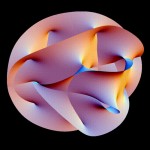 The number of dimensions possible in the universe is hotly debated in physics. I’ve seen the number 11 thrown around a lot, for example, although as I understand it most of these dimensions are thought to be somehow “folded into” the four we directly experience. I honestly don’t know what that means, let alone how to envision it. But another even more interesting theory holds that our purely common sense perception of space and time actually overestimates the spatial dimensionality of our world—that there are actually just two dimensions of space, and that the third dimension (volume) is an illusion.
The number of dimensions possible in the universe is hotly debated in physics. I’ve seen the number 11 thrown around a lot, for example, although as I understand it most of these dimensions are thought to be somehow “folded into” the four we directly experience. I honestly don’t know what that means, let alone how to envision it. But another even more interesting theory holds that our purely common sense perception of space and time actually overestimates the spatial dimensionality of our world—that there are actually just two dimensions of space, and that the third dimension (volume) is an illusion.
This is the holographic theory proposed by Dutch physicist Gerard ’t Hooft as an outgrowth of string theory, to explain quantum gravity. Wikipedia describes it this way: “the theory suggests that the entire universe can be seen as a two-dimensional information structure ‘painted’ on the cosmological horizon, such that the three dimensions we observe are an effective description only at macroscopic scales and at low energies.”
Quantum physics is mostly beyond me, I admit, but I do understand general relativity, and doesn’t Einstein’s work already suggests this possibility? As an object approaches the speed of light (gaining mass and energy), it is flattened in the direction of travel, becoming two dimensional; it thus makes some sense that in the “light world” of high-energy particles, two-dimensional space would have to be the norm.
And thus, instead of some kind of enhanced depth, as movie special effects like to portray it, hyperspace would actually be a flat, picture-like place.
From Flatland to Fatland and Back Again
I realize that “painted” is being used somewhat metaphorically in Wiki’s summary, but artistic illusions of spatial depth on flat surfaces (which was partly the subject of my PhD dissertation several years ago) suggest other possible interpretations for how UFOs may actually be interacting with our world—not from higher dimensions but from lower ones.
 Hans Holbein’s 1533 painting The Ambassadors (at the top of this post) shows a typical Renaissance scene of two important men surrounded by sumptuous worldly goods, but jutting across the bottom of the painting is a strange elongated object (left). From straight on, it doesn’t really look like anything—it has been compared to a baguette—and a viewer might even overlook or ignore the anomaly, regarding it as a mistake or a stain of some kind. It is actually an example of anamorphosis—an image only visible from a very oblique angle.
Hans Holbein’s 1533 painting The Ambassadors (at the top of this post) shows a typical Renaissance scene of two important men surrounded by sumptuous worldly goods, but jutting across the bottom of the painting is a strange elongated object (left). From straight on, it doesn’t really look like anything—it has been compared to a baguette—and a viewer might even overlook or ignore the anomaly, regarding it as a mistake or a stain of some kind. It is actually an example of anamorphosis—an image only visible from a very oblique angle.
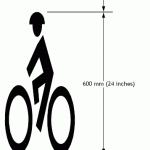 Anamorphosis is widely used nowadays to make lettering and icons on roadway surfaces visible from the steep angle of a driver moving toward them (e.g., the bicycle at right), but it is also a clever way to put hidden images in pictures. When you stand off to the right side of The Ambassadors, up near the canvas, the “baguette” becomes visible as a skull (below). Skulls were commonly included in paintings of the period—especially paintings showing displays of wealth—as symbols of vanitas, or the transitoriness of life, reminding the viewer not to get too attached. We don’t know if Holbein was being deliberately mischievous with his anamorphic skull, but he was certainly showing off his skills with perspective (then a relatively recent invention), since anamorphosis requires considerable advance planning and mathematical precision.
Anamorphosis is widely used nowadays to make lettering and icons on roadway surfaces visible from the steep angle of a driver moving toward them (e.g., the bicycle at right), but it is also a clever way to put hidden images in pictures. When you stand off to the right side of The Ambassadors, up near the canvas, the “baguette” becomes visible as a skull (below). Skulls were commonly included in paintings of the period—especially paintings showing displays of wealth—as symbols of vanitas, or the transitoriness of life, reminding the viewer not to get too attached. We don’t know if Holbein was being deliberately mischievous with his anamorphic skull, but he was certainly showing off his skills with perspective (then a relatively recent invention), since anamorphosis requires considerable advance planning and mathematical precision.
 Could anamorphosis help explain the elusive behavior of UFOs?
Could anamorphosis help explain the elusive behavior of UFOs?
The notion of portals or wormholes is popular nowadays in ufology, but the holographic hypothesis raises the possibility that UFOs could be sliding into and out of our (apparently) 3-D world from some high-energy Flatland—like a note slid under a door rather than a person opening it up and stepping through.
High-energy Flatlanders (or perhaps more likely, high-energy exotic technology capable of carrying ordinary 3-D beings from place to place via flat hyperspace) could be nearly invisible or completely non-understandable except when seen from a specific vantage point. This by itself is suggestive, given the fleeting, elusive, hard-to-verify nature of so many UFOs. Who knows?—Our eyes may pass over high-energy beings or technology all the time, but our visual system may generally ignore such anomalies because they make no sense or just blend into their surroundings.
I have long been troubled by the “higher dimensions” hypothesis, partly because it seems so unfair: If higher spacial dimensions reality exist, why would our cognitive faculties be so blind to them? What point is there for us to be only conscious of some of the dimensions available, in contrast to supposed higher dimensional beings who can dip into our impoverished reality occasionally and pity us? I am inclined to think that, with dimensions as with so many other things, less is more, and already our four dimensions are an embarrassment of riches. It may be our visitors (or their technology) that are “dimensionally challenged,” not us.
Somebody could write a sequel to Flatland, called Fatland, about spheres trying to come to grips with the appearance of a circle among them. Inevitably the Flatlander (circle) would appear merely as a line at first, and only widen out into a visible narrow oval and then finally a circle as it drew very close to an observer, but quickly it would dwindle to a mere line again as it receded. From most vantage points it would blend in or at least not be very distinct or salient, and there would be very little agreement among the spheres as to whether there was even anything there at all, let alone what its shape really was.
The Anamorphic Wedge
I want to briefly consider one further aspect of painterly anamorphosis that is suggestive for UFOs—this time in terms of the “control system” hypothesis advocated by Jacques Vallee.
As I said, anamorphic images can only be seen from a very restricted point of view—while one person sees the image, other people standing straight in front of the painting will see nothing, or will not know what they are looking at. Such images thus serve as kind of a wedge between consensus reality and the solitary, privileged viewpoint of the (intended) witness.
There are more aspects to this social-psychological effect of anamorphosis than first meets the eye.
Besides revealing itself to the selected witness, an anamorphic image also, in some sense, “frames” the rest of those viewers in his/her field of vision. Other people are suddenly seen standing there in front of the painting but blindly missing its point or its “true meaning.” In other words, anamorphosis not only displays itself as a hidden secret (thereby making the intended viewer feel special and chosen), it also highlights the ignorance and limited perspective of others in one’s social imaginary. Whether “the ignorance of the masses” is an accurate portrayal or not, it could be part of the intended take-away from a UFO encounter.
What’s more, social separation or isolation or even ostracism of the witness could be the intended effect, not just an unfortunate byproduct, of such an encounter. It’s at least a possibility to keep in mind, that UFOs, whatever they are, could be anamorphic phenomena aiming not only to manipulate or deceive witnesses but also to socially and psychologically isolate them, or separate them from the herd.
Anti-Anti-Tricksters
Over on UFO Conjecture(s), Rich Reynolds takes issue with the notion of “The Trickster” that is being increasingly invoked in ufology:
“Just as Christians and other religious aficionados think Satan or angels are real beings, ufologists like to use The Trickster as a real being, causing some UFO sightings or events. It’s an ignorant stance. Even as God is an iffy reality, The Trickster is so much more so. I would hope that readers here would refrain from stretching credulity to a breaking point by using The Trickster metaphor as an explanation for some UFO events.”
Reynolds is right that the Trickster concept can’t serve as an explanation. But at least in my reading of the topic, including George Hansen’s massive study The Trickster and the Paranormal or books tangentially invoking the concept, like Colm Kelleher and George Knapp’s Hunt for the Skinwalker, the term isn’t being used in a literalistic way to denote a “real being.” Rather it is being used, quite appropriately I think, as a shorthand term for a type of sentience or intention that seems to underlie a wide range of paranormal phenomena (ranging from UFOs to psychic experiences to hauntings) and that has a distinctly ironic, thwarting character. There’s no other term that quite fits the bill as well as “Trickster.”
I don’t see people using the term to mean a literal god or godlike being (a la Coyote or Hermes … or Satan, for that matter) whose purpose and mission is to screw with human affairs. The whole point of using the term is to avoid pinning UFOs’ origins down in all the ways they have been too narrowly pinned down throughout the history of ufology. It is far, far preferable to the term “extraterrestrials,” for instance—which truly is a completely distorting, biasing, pigeonholing rubric that has done untold damage to the field of ufology. (If I could beg ufologists to stop using any term, it would be that one, as there is no actual evidence, in all the millions of UFO encounters since the dawn of recorded history—and how could there be?—that the intelligences responsible, wherever they may occasionally say or imply they originate, are actually from other planets.)
Trickster is a useful term because it leaves the door wide open as to causation and origin while being descriptive of a very particular and peculiar phenomenology of many UFO experiences: the distinct and uncanny sense that there is not only a sentience underlying it but that this sentience can anticipate our actions in order to thwart our efforts at studying it. As an alternative, John Alexander offers the term “precognitive sentient phenomena”:
“The precognitive sentient phenomena concept suggests that there is some external controlling agent that initiates these events that are observed and reported. It appears as though that agent not only determines all factors of the event, but is already (i.e. precognitively) aware of how the observers or researchers will respond to any given stimuli. The agent can be considered like the Trickster that is always in control of the observations. Every time researchers get close to an understanding of the situation, the parameters are altered or new variables are entered into the equation.”
Precognitive sentient phenomena is a good term, but it is a mouthful. Trickster is a handy placeholder and shorthand … that is, pending some kind of a real explanation.
The Trickster does not refer simply to life’s tendency to have ups and downs, as Reynolds suggests in his post, but to something much more specific. Signaling as it does a nod to archetypal psychology, the term registers the possibility (at least) that these phenomena may be linked to our own consciousness or unconscious in ways we don’t yet fathom. Plus, the fact that world mythologies and folklore have always included beings who personify precisely these “precognitive sentient” qualities that are seen again and again not only in ufology but also in parapsychology is itself highly suggestive of something … and I don’t think anyone who uses the term precisely knows what, but it’s a useful fact to keep in the back of our minds.
That said, however, it is good to be wary of such placeholder terms, because they do sometimes end up sticking around long past their due date—and this is especially true of other terms associated with Jungian psychology. “Synchronicity” is such a term, which did not actually denote an original concept (Paul Kammerer had already described essentially the same thing with his notion of “seriality”) and has never been useful in helping us theorize ESP. In a future post I will argue that parapsychologists and “synchromystics” should avoid using Jungian vocabulary, because many of his once-novel terms and metaphors have now become conceptual straightjackets limiting our thinking.
I’m not worried about The Trickster, however, because its application to ufology and other unexplained phenomena is relatively new and harmless, and it’s much better than constantly talking about “ET.” But if he’s still hanging around in 10 or 20 years, that may indeed start to get awkward.
The Biggest Bullshit: David Lynch and the Cowboy
Well, there are many kinds of films. Most of them, nowadays, don’t demand much thinking. That makes me very, very upset. It makes me upset that they think the audiences have grown unused to thinking and that they only want things spelled out for them, in a platter. That’s bullshit, and a big one. People love to think. We are all detectives. We love to observe, we love to deduce. It is great to pay attention. We have a lot of fun this way. — David Lynch, on Mulholland Drive
You’re not thinking. You’re too busy being a smart-aleck to be thinking.—The Cowboy, Mulholland Drive
Suffering comes from the energy we perpetually expend in keeping up appearances of knowing, the constant knowing attitude we take toward life. Been there, done that, same old same old. It becomes the armor we clothe ourselves with—projecting this image that I know who I am, and why I’m here, and what I’m doing. In the postmodern world, this attitude has become institutionalized in sarcasm, ironic detachment, snarky jadedness, and (to use the Cowboy’s anachronistic expression) being a smart-aleck.
How true, the words of the Cowboy: We go through our lives taking a too-cool-for-school, smart-alecky attitude toward the givens of our lives, and as a result, fail to think and pay attention.
The Zen masters tried to get their pupils to stop knowing, to un-know, and they had different ways of doing it. The Soto school made the monks just sit, stop imagining they had anything more important to do or anyplace better to be. It’s much tougher than it sounds. It appealed (and still appeals) to students who naturally have calm, relaxed, patient minds. The Rinzai school, on the other hand, used story-puzzles, or koans, and appealed (and still appeals) to active intellects who naturally can’t resist interpreting and solving puzzles. Koans invite intellectual analysis, but at a certain point—weeks or months later—the intellect runs aground, and suddenly the monk finds himself or herself in a transfigured place.
“Rinzai” is how the Japanese pronounce the name of the 9th-Century Chinese master Lin-Chi. David Lynch says of his film Mulholland Drive that “We are all detectives. We love to observe, we love to deduce.” He understands people’s love of interpretation, of playing detective, and I would bet money he created Mulholland Drive as a deliberate koan. If meditated upon at sufficient length, it can take you to a place beyond interpretation. But we have to go through that effort of intellectual interpretation in order to awaken, to transcend. When we do that, we find ourselves not in a meaningless depressing world but in an enlarged, more immense, more spacious place that is full of possibility and importance and power.
I wrote in another post that Mulholland Drive specifically lures you to distinguish the “dream part” from the “real part” of the main character Diane’s (Naomi Watts’) story. Innumerable clues are there to indicate that the first two-thirds of the film, right up until the Cowboy’s “Hey pretty girl, time to wake up,” are meant to be seen as a textbook wish-fulfillment dream sequence that scrambles, rearranges, and transforms all the elements of Diane’s depressing “real-life” predicament—that she has hired a hit-man to kill her glamorous actress lover Camilla (the amnesic dark-haired “Rita” in the dream) after the humiliation and heartbreak of the latter’s rejection of her and announced engagement with a famous film director, Adam Kesher.
After a couple viewings of Mulholland Drive, this interpretation emerges pretty clearly and naturally. The film has thus been compared to The Wizard of Oz: The long dream core of the film consists of elements from the main character’s real life but jumbled and transformed according to dream logic, to create a fantasy that removes all the pains of the dreamer’s existence, erasing all of her guilt, and giving her all the things she wishes for. Textbook Freud.
Almost.
Once you’ve performed this “natural” interpretive procedure that the film invites, and followed it to its conclusion, you discover that you’ve been led into a trap: When you put the final piece in place, the film shows a message that was not visible before. This is the real genius of a film that is already genius on every more superficial level.
The key to the hidden message is the Cowboy.
The first time we (the audience) see the Cowboy is when he berates Adam Kesher for being a smart-aleck and for thinking he can have any woman he wants as the lead in the film he is making. He also says “You’ll see me once more if you do good, twice if you do bad.” Although it is addressed to the buffoonish Kesher, we likely take this promise as meant for “Betty,” the “real world” Diane, whose story this all really seems to be.
But … if we follow Diane’s “real” chronology as reconstructed in the aforementioned Wizard of Oz interpretation, this dream appearance is actually the second time Diane sees him—the first having been when he briefly walks through the room at the party where Adam and Camilla (dream Rita) announce their engagement. Diane’s dream has transformed this single fleeting “day residue” into one of two central psychopomps in the film (the other being the Club Silencio emcee), and her unconscious creates the dream of the Cowboy chastising and threatening Kesher that he’ll appear twice more if he does bad. This means Diane, the “real” subject of the movie, encounters the Cowboy only once more after this warning before she dies: When he appears at the end of her dream, in her doorway, and tells her it’s time to wake up.
We could interpret this as indicating that Diane has done well … done well, perhaps, by killing herself—after all, her life has become untenable, as she has had her former lover killed and the detectives know, and are knocking on her door. There is no other way out for her but to blow her brains out.
But let’s face it: If it isn’t Diane who’s being bad, then it is us, the viewers, who are being bad, since we do see the Cowboy two more times after his first appearance at the Corral.
Gulp. What did we do wrong? How are we being bad?
The Cowboy has already told us plainly: By being smart-alecks. Smart alecks don’t think they need to pay attention and think about what’s being said to them, because they think they already know, already have things figured out. But of all films, Mulholland Drive is designed as a big demonstration that no, we (we audience members, we human beings) do not have it figured out, and we are in fact very poor learners.
Lynch has said that one of his earliest films, a short called Alphabet, was about the “anxiety of learning.” This theme is clearly alive and well in Lynch’s late works too: Like the characters in his films, we are made to feel dumb by what he shows us. The Club Silencio emcee assures us that there’s no band, that it’s all a recording, and yet we are surprised when a trumpet player stops fingering his instrument and the music continues. And just minutes later, as Rebekah Del Rio sings “Crying,” we are just as amazed when she collapses on stage and her recorded voice continues to sing as we were when the trumpet player stopped playing.
So the Cowboy and the emcee at Club Silencio are both stand-ins for Lynch the Master, Lynch the teacher, who like his close namesake Lin-Chi famously just barked at or struck his pupils get them to see the light.
In Mulholland Drive, we are being shouted at by a teacher whose impatience is, despite his ferocity, infinitely compassionate. This is because his works have a real-world purpose. They are initiations: He is trying to transmit a bit of learning that has been important to him and that he really wants to share with us. We won’t get it as long as we are being smart-alecks, so he is in effect slapping us in the face to get us to stop that behavior long enough to see what he is talking about.
 I explained in my earlier post that what he’s trying to get us to see is that there’s no “real” and no “not real” in the film—they are fundamentally the same, just following different narrative rules, just shot in different styles, to lead us into the trap of picking them apart and distinguishing them. It’s like Lynch has taken us on this long, very enjoyable journey, getting us to play detectives (who are, as we speak, knocking loudly on the door), only to lead us to a back alley where we are shown Rene Magritte’s painting The Treason of Images—with a picture of a pipe on a school blackboard and the caption “This is not a pipe”: There’s no “dream” and no “reality” in Mulholland Drive—it’s a movie, stupid. All parts are equally fictional; nothing is more real than anything else. It’s all equally unreal. It’s all a recording.
I explained in my earlier post that what he’s trying to get us to see is that there’s no “real” and no “not real” in the film—they are fundamentally the same, just following different narrative rules, just shot in different styles, to lead us into the trap of picking them apart and distinguishing them. It’s like Lynch has taken us on this long, very enjoyable journey, getting us to play detectives (who are, as we speak, knocking loudly on the door), only to lead us to a back alley where we are shown Rene Magritte’s painting The Treason of Images—with a picture of a pipe on a school blackboard and the caption “This is not a pipe”: There’s no “dream” and no “reality” in Mulholland Drive—it’s a movie, stupid. All parts are equally fictional; nothing is more real than anything else. It’s all equally unreal. It’s all a recording.
If we need confirmation, only note the absence of a “real world” counterpart of the mysterious blue box. It is opened in the “dream” by the strange blue key. A mundane version of the blue key is conspicuous in depressed Diane’s apartment at the end, and in a flashback, it is shown to her by the hit man in Winky’s diner, who says she’ll find it “at the place I said” when he has finished his job of offing her lover Camilla (dream Rita). Diane asks, naively, “What does it open?” The hit man gets a quizzical look and just laughs and shrugs at her dumb literal-mindedness: The point is, the key is a message, not actually a functional key that opens anything. There’s no “real” box … just like there’s no band.
A teacher of Tibetan dream yoga, Tenzin Wangyal Rinpoche, writes that “ultimately the meaning in the dream is not important. It is best not to regard the dream as correspondence from another entity to you, not even from another part of you that you do not know. … It may sound strange, but this idea of meaning must be abandoned before the mind can find complete liberation. … Instead penetrate to what is below meaning, the pure base of experience.”
I don’t know if Lynch has ever said it explicitly, but I suspect he would say it, so I’ll venture: Movies, like dreams, can seduce and delight us with their obvious and hidden meanings, but ultimately they should take us to a place beyond meaning. Have fun decoding them, but don’t think that’s enough, that it is just about proving your cleverness; learn to see through the movie to the Real. Lynch’s later movies invite us to interpret and find meaning, but they are koans—traps meant to take us to a higher place. Mulholland Drive is his most exquisitely designed trap.
***
Menopausal Mystics in Space
In my “Psychic Astronauts” post several months ago I thought I was being somewhat original by imagining a hypothetical cost-efficient scenario for our future exploration and colonization of space—one that made use of the interesting (at-this-point-unproven, admittedly highly controversial) notion of nonlocal mind. Specifically, I suggested that highly trained psychic explorers could remote view distant planets, visit them astrally (or, to be pedantically precise, etherically), telepathically manipulate organisms there across vast epochs of their evolutionary history (remembering that nonlocality applies to time as well as space), and then psychically inhabit or “possess” specially bred remote host vessels.
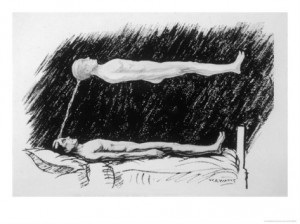 Faxing ourselves across space and time in this fashion sounds convoluted and crazy … but basically, if there is any truth to the claims of psychic researchers, remote viewers, and mystics since time immemorial, then there’s really nothing (other than our own present lack of development of those capacities) that would inherently prevent such a possibility. A project to train hundreds or thousands of psychic astronauts would be far less costly (and time consuming) than even a mere manned Mars mission, let alone a Star Trek-style space program.
Faxing ourselves across space and time in this fashion sounds convoluted and crazy … but basically, if there is any truth to the claims of psychic researchers, remote viewers, and mystics since time immemorial, then there’s really nothing (other than our own present lack of development of those capacities) that would inherently prevent such a possibility. A project to train hundreds or thousands of psychic astronauts would be far less costly (and time consuming) than even a mere manned Mars mission, let alone a Star Trek-style space program.
I was certainly aware that this plan mashes together various ideas that have all appeared in science fiction—especially from the more open-minded, less slavishly scientistic era of pulp. H.P. Lovecraft, with his telepathic slumbering Old Ones, springs immediately to mind. (More recent scenarios of prehistoric alien visitation/intervention—such as those of Erich von Daniken, Zechariah Sitchin, and lately Ridley Scott—are more mundanely nuts-and-bolts, using actual spaceships, etc., in keeping with the dogmatic materialism of our day.) Until today, though, I had no idea of the true pedigree of the concept of psychic astronautics.
In a landmark archaeology of what could be called ‘ancient psychic astronaut theory’ on his blog The Secret Sun, Christopher Loring Knowles reveals that the Theosophical writings of Alice Bailey, especially her 1922 book Initiation: Human and Solar—supposedly channeling a Tibetan Ascended Master named “Djwal Khul”—describe precisely the scenario I sketched, albeit in reverse: the psychic colonization of Earth (via astral travel) by beings from the Sirius star system, who shaped ape-men into human beings to serve as receptacles for their consciousness.
Knowles is less interested in the crazy scenario than in its literary borrowing (too weak a word) by Lovecraft himself. In a point-by-point comparison, he shows that the parallels between Lovecraft’s “Call of Cthulhu” and Bailey’s channeled revelations about Earth’s distant past are so close as to be essentially plagiarism. Knowles suggests that the Darwinian Lovecraft originally wrote his dark novella in 1926 as a parody of the Theosophist’s occult ideas, but that he then carefully omitted all mention of Bailey’s book to his friends, not wanting to betray the unoriginality of his basic (and, in his hands, pretty damn cool) cosmic premise.
Though it doesn’t really dim my appreciation for Lovecraft, I love Knowles’ discovery. He notes that Theosophy, with its violet-hued astral planes and Ascended Masters in flowing gowns, was written mainly for an older, female audience. Terence McKenna (for whom the real ancient astronauts were the Stropharia cubensis mushroom) derisively referred to this demographic as “menopausal mystics.” Although there is a lot that is unoriginal, deeply questionable, and by modern standards rather un-awe-inspiring in the Theosophists’ cosmological visions, there is also much of value in their writings—particularly if you are open minded to the idea of siddhis, psychic abilities, and human potential in general. And they certainly supplied plenty of cool and original ideas to a generation of sci-fi writers who were less fetishizing of technology and more open-minded about the future (and past) of consciousness than many present-day writers.
Wouldn’t it be strange, and sort of wonderful, if mankind’s real future in space turned out to more closely resemble the channeled revelations of an early 20th Century menopausal mystic than the promethean hi-tech visions of Arthur C. Clarke and Stanley Kubrick, or Ridley Scott?
Lost and Found in Psychic Space: Airplanes, Aviators, and ESP
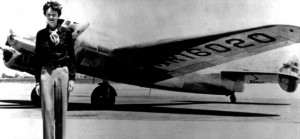
I’m fascinated by how aviation and missing planes are so often linked, in one way or another, to ESP phenomena. The ongoing, frustrating search for Malaysian Flight 370 seems like the perfect opportunity to write down some thoughts about this strange nexus.
There’s a long history of psychics being enlisted (or volunteering) to search for lost planes, for one thing. One of the best-known successes of the early operational remote viewing work at Stanford Research Institute (SRI) was the successful location of a lost Soviet spy plane in the African jungle using the talents of viewers Gary Langford and Rosemary Smith. The annals of remote viewing (as described in Jim Schnabel’s excellent history of the subject) include other successful searches for missing aircraft. At Fort Meade for example, Ken Bell accurately pinpointed the site of a military crash in Virginia (even getting the name of the mountain, “Bald Knob”). On another occasion, he successfully remote-viewed the burned wreckage of an American helicopter that had crashed high in the Andes in Peru, killing the crew.
So it is to be expected that today’s most accomplished remote viewers and other psychics are being recruited to search for the missing Malaysian jet. Uri Geller, quite naturally, says he has been asked by a “substantial figure” for help in the search. Geller is more famous for telekinetic and telepathic feats than for clairvoyance, but he made his fortune map-dowsing for mineral and oil deposits—a skill one would think is not too different from viewing lost objects at a distance. He has not pointed to an actual location for the presumably downed plane, that we know of. But according to The Anomalist, remote viewer extraordinaire Joe McMoneagle, one of the original Fort Meade team, has also been tasked in the search; he says he has “duly reported” his findings.
 When scientific or military professionalism and rigor are not involved, psychic attempts to locate missing aircraft are, as one can imagine, often not only unsuccessful but even tragically misleading. In his thorough and riveting account
When scientific or military professionalism and rigor are not involved, psychic attempts to locate missing aircraft are, as one can imagine, often not only unsuccessful but even tragically misleading. In his thorough and riveting account of the Uruguayan rugby team lost in the Andes in 1972, Piers Paul Read documents the desperate families’ use of psychics to help in the search. A Belgian clairvoyant, Gerard Croiset Jr., was recruited, and although he described several specific details that ultimately proved accurate (such as a nearby sign reading “Danger” and the physical appearance of wreckage itself), he insisted the plane went down near a lake over 80 miles south of the crash site—resulting in much money, time, and effort being wasted searching in the wrong place.
The sad irony is that the first psychic consulted by parents of two of the lost boys, a dowser in a poor Montevideo neighborhood, turned out to have precisely pinpointed the location of the downed plane. Unfortunately the area he picked had already been overflown on early search flights and was, in any event, deemed too dangerous and remote for further searching. (Read’s book Alive contains more tantalizing ESP-related tidbits, including accurate premonitions of imminent rescue by some of the survivors; the more recent documentary Stranded includes survivors’ fascinating accounts of their near-death experiences during an avalanche that struck 16 days into their ordeal and killed 8 of their companions.)
Then of course there’s Amelia Earhart.
When Earhart went missing in her Lockheed Electra in 1937, her husband George Palmer Putnam was inundated with mail from psychics and others who insisted they knew where Earhart’s plane had gone down, had had dreams of her, or had actually communicated with her psychically in the days and weeks following the disappearance. A 1940 article in Popular Aviation, which has been made available as a pdf on the Earhart Project website, is a great read and another fascinating account of the paranormal giving hope to those desperate to find their loved ones but also hopelessly muddying the waters of an investigation of a lost flight.
 The Popular Aviation article only details a few of the examples of the messages Putnam received, unfortunately, but the ones described are particularly interesting in light of the unfolding (but lately stalled due to legal problems) efforts of the The International Group for Historic Aircraft Recovery (TIGHAR) to piece together Earhart’s last days and recover remains of the Electra. From what one can glean from the 1940 article, psychic consensus seemed to be that she and her navigator Fred Noonan went down somewhere north of Howland Island—not south, in the direction of Nikumaroro atoll, where TIGHAR has found tantalizing evidence that the flyers actually ended up. However, people who corresponded with Putnam said that they knew she had survived the crash and was on an island or atoll, and provided scenes that correspond to the picture being assembled by TIGHAR—that the famed aviatrix and her companion survived, possibly for a few weeks, before perishing (probably from dehydration).
The Popular Aviation article only details a few of the examples of the messages Putnam received, unfortunately, but the ones described are particularly interesting in light of the unfolding (but lately stalled due to legal problems) efforts of the The International Group for Historic Aircraft Recovery (TIGHAR) to piece together Earhart’s last days and recover remains of the Electra. From what one can glean from the 1940 article, psychic consensus seemed to be that she and her navigator Fred Noonan went down somewhere north of Howland Island—not south, in the direction of Nikumaroro atoll, where TIGHAR has found tantalizing evidence that the flyers actually ended up. However, people who corresponded with Putnam said that they knew she had survived the crash and was on an island or atoll, and provided scenes that correspond to the picture being assembled by TIGHAR—that the famed aviatrix and her companion survived, possibly for a few weeks, before perishing (probably from dehydration).
An interesting angle in this case is that Earhart herself was an accomplished psychic—although she publicly downplayed her talents in an era that was just as rationalistic and skeptical as ours. She had a particular knack for finding missing aircraft. As described by two newspaper columnists quoted by David K Bowman:
“Officials at first were inclined to laugh at Miss Earhart’s psychic messages. But her accuracy now has them mystified. When a United Airlines plane was lost just outside of Burbank, Calif. Dec. 27, Miss Earhart called the United Airlines office and told them to look on a hill near Saugus, a little town north of Burbank.
“There the wreckage was found.
“Again when the Western Air Express plane carrying Mr. and Mrs. Martin Johnson crashed Jan. 12, Miss Earhart reported the plane to be near Newhall, 15 miles north of Burbank, where it was found.
“In the earlier crash of the Western Air Express in Utah, Miss Earhart had a vision to the effect that the bodies of the dead had been robbed by a trapper. Two days later, a trapper near Salt Lake City reported finding the wreckage, but then suddenly disappeared without giving the location of the plane.”
There seems to be a link between a penchant for real-world flying and psychic aviation. For example, decades after his historic trans-Atlantic solo flight, Charles Lindbergh admitted in a memoir that during the 33-hour journey, during which he did not dare actually fall asleep, he experienced a hypnagogic, dissociative state in which he felt his body, soul, and spirit separate—what we might now call an out-of-body experience. During this experience, the flyer perceived and communicated with angelic beings accompanying him in his plane. The encounter left him with a lasting interest in the afterlife and immortality.
A more recent example is the popular author and aviator Richard Bach. After the CIA withdrew funding from the SRI project in the late 1970s (wanting to distance itself from questionable research in the aftermath of revelations about MK-ULTRA and other projects), Hal Puthoff and Russell Targ became increasingly creative in seeking support for their research at SRI. One person they sought out for possible help was Bach, whose bestseller Jonathan Livingston Seagull seemed (to Targ at least) like an account of an out-of-body experience—a phenomenon with strong continuity with remote viewing. On the hunch that Bach might be interested to participate in some psychic research himself and perhaps give some money to SRI, Targ and Puthoff invited Bach to California to take part in some experiments.
The writer proved quite talented. For example, in one out-bounder experiment described in Targ and Puthoff’s book Mind-Reach, he gave a very accurate physical description of the interior of a modern A-frame Methodist church and its altar—although in a case of “analytical overlay” biasing his interpretation, Bach thought the altar with the cross behind it looked like (appropriately enough) an airport ticket counter with a fleur-de-lis airline logo. Jacques Vallee, SRI Arpanet pioneer and friend to the remote viewing program, describes in his journals that he arranged to have a computer terminal installed in Bach’s Florida home, where Bach participated in a networked, cross-country remote viewing experiment in which he was remarkably accurate in describing an assortment of minerals chosen by a geologist.
The longest-distance psychic experiment ever conducted by an aviator, or anybody, is no-doubt that conducted by astronaut Dr. Edgar Mitchell aboard Apollo 14 in 1971. Like previous aviation pioneers, Mitchell had a profound mystical experience during his journey; but quite apart from this, he had a longstanding interest in ESP and, at four predetermined times during the mission, telepathically transmitted randomly selected Zener symbols (the type used in the classic Rhine experiments) to a small group of psychics back on Earth. He reported that there were 51 correct responses out of 200 total—slightly better than chance (there are 5 symbols in a Zener deck, so 40 correct responses would be predicted by chance). It is typical of the interesting but rather uninspiring positive results produced by classical psi research before the SRI era.
 The great precedent for Mitchell’s long-distance telepathy experiment, however, is far more inspiring. In 1938, a dashing, larger-than-life aviator and all-around hero explorer, Sir George Hubert Wilkins (left), volunteered on a dangerous mission to the arctic to search for a lost Russian plane and hopefully rescue the crew. Before he departed, he arranged to mentally send updates of his adventure at regular times each week to a New York writer with an interest in ESP named Harold M. Sherman. Sherman, for his part, recorded his impressions and had them notarized to prove that no cheating had transpired. Wilkins and Sherman documented the results in their classic book Thoughts Through Space
The great precedent for Mitchell’s long-distance telepathy experiment, however, is far more inspiring. In 1938, a dashing, larger-than-life aviator and all-around hero explorer, Sir George Hubert Wilkins (left), volunteered on a dangerous mission to the arctic to search for a lost Russian plane and hopefully rescue the crew. Before he departed, he arranged to mentally send updates of his adventure at regular times each week to a New York writer with an interest in ESP named Harold M. Sherman. Sherman, for his part, recorded his impressions and had them notarized to prove that no cheating had transpired. Wilkins and Sherman documented the results in their classic book Thoughts Through Space.
The records of Sherman’s and Wilkin’s experiment are remarkable, and resemble the sometimes astonishing accuracy of later CIA and military clairvoyants when real-world events and locales, rather than boring randomly generated cards, are involved. Reading the book through the lens of hindsight, it becomes clear—as it even became clear to the participants themselves when Sherman’s impressions were checked against Wilkins’ periodic bulletins—that “thoughts through space” did not accurately characterize the signal line through which Sherman received his information. Wilkins admitted he was often too busy, or simply forgot, to send his mental messages at the appointed times, but this did not prevent Sherman from obtaining detailed, usually accurate impressions of Wilkins’ activities and whereabouts.
In other words, Sherman was engaged precisely in remote viewing, not telepathy or (to use Upton Sinclair’s term) “mental radio.” Had it occurred to either of the experimenters to have Sherman psychically search for the missing Russian plane himself and thus serve as Wilkins’ guide rather than just his remote “receiver,” Wilkins’ mission may have been more successful than it was—but that would have required a paradigm shift in parapsychological thinking that was still over three decades off.
The experiment with Sherman is, to my knowledge, the first and last time Wilkins participated in an ESP experiment. Sherman, however, went on to write several interesting popular guides to developing ESP powers, not to mention numerous pulp sci-fi novels. In fact, he is a strangely absent figure in the nexus of psychic abilities, human potential, and sci-fi so densely chronicled by Jeffrey Kripal in his great book Mutants and Mystics.
In any case, there seems to be something fascinatingly archetypal about this nexus of aviation and ESP. Flying through air and space—and the extreme lengths to which one can get lost doing so—seem almost like a hieroglyph, in mundane 4-D reality, of how far one can travel and also get lost in the dimensionless space of consciousness and psychic abilities (or dis-abilities). Time will tell if and how this archetype plays out in the story of Flight 370. As The Anomalist notes, there may be little hope of anyone’s (even Geller’s or McMoneagle’s) ESP-derived insights having an impact on that search, given that there are bound to be hundreds or more intuitives, psychics, remote viewers, etc. giving their own conflicting reports. If I were one of the “authorities” involved, this is one reason I would be cautious following leads obtained from the paranormal information superhighway, however tantalizing they may be.
Postscript: Wilkins, The Nautilus, and SRI
Oddly enough, it is through an interesting mix of coincidence and distorted memory that Wilkins’ and Sherman’s Thoughts Through Space experiment may have had a decisive influence on the later research at SRI and the whole history of remote viewing.
According to Jim Schnabel, a 1960 report in the French magazine Science et Vie claimed that the nuclear submarine USS Nautilus had conducted a telepathy experiment on its historic voyage under the North Pole in 1958. Upon closer scrutiny, the claim proved to have been either fraudulent or based on fabricated information, but nevertheless it spurred anxiety on the part of the Soviets that the United States was developing psychic abilities for military application, and they began pouring money into paranormal research. It was this development, reported in Psychic Discoveries Behind the Iron Curtain in 1970, that in turn triggered anxiety in US intelligence and military circles that we may lose the psychic arms race if we didn’t fund such research ourselves. Hence SRI, and the subsequent developments at Ft Meade and elsewhere.
According to Schnabel, the source of the Science et Vie story that started the false rumor of US psychic research in the 1950s is unknown—it was either a hoax or may have been a deliberate disinformation ploy to get the Soviets to waste their money on paranormal woo. But I suspect the story could actually have arisen from a more innocent case of distorted recollection by someone involved in the magazine article or their sources, because it involves a fascinating, tangled knot of coincidences.
Several years before his 1938 arctic aviation expedition with its telepathy component, Wilkins had himself attempted to reach the North Pole underwater, in a decommissioned American submarine O-12 that he had leased from the Navy and rechristened, wait for it, The Nautilus. I think it would have been all too easy for someone to later conflate the various adventures of this dashing polar explorer (who sometimes engaged in telepathy experiments) with the news of the first actual polar crossing by a (this time nuclear) submarine, also named Nautilus, in 1958.
To make things more confusing, the nuclear Nautilus‘s first commander was named … Wilkinson.
Kafka and the UFO Gnosis
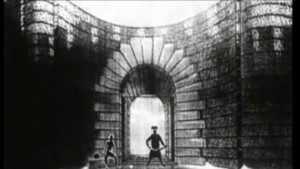
Rich Reynolds has a nice piece over on UFO Iconoclast comparing ufology to Samuel Beckett’s existentialist play Waiting for Godot. It’s a really apt comparison: The two main characters wait around for a person who is never going to come, and this waiting keeps them from becoming fully conscious and responsible for their lives.
A similar comparison I would make is to practically everything by Kafka. Ufology is murky, increasingly maddening, and you are perpetually unclear where you stand; you seem to be on the brink of figuring out some piece of the puzzle, and then you realize you are at the back of a line of aging people who have been standing in that same line their whole life, clutching essentially the same speculations in their dusty binders and briefcases, still awaiting confirmation from some authority that they have made progress though they have essentially gotten nowhere.
The whole idea of “disclosure,” particularly, reminds me of the central parable of The Trial. A man from the country comes before the Door of the Law, wanting access, but he is stopped by a doorkeeper who makes him wait, although not without accepting bribes “just so you don’t feel you’ve left anything untried.” The man waits his whole life, and finally, as he’s about to die, he finally asks the doorkeeper, “Why, if this is the Door of the Law, has no one else come seeking entry all this time?” To which the doorkeeper says, “Because this door was meant for you alone. I’m now going to shut it.” A brilliant light shines from deep within the edifice as the door is shut.
I see it as a sort of Gnostic lesson having to do with experience versus faith. The only important knowledge is experiential self-knowledge, and it can’t be thought of as coming from outside oneself, in the form of a religious or secular authority (such as the government, the UFOs themselves, or any other “subject presumed to know”—to borrow a term from psychoanalysis). You’ll get nowhere until you include the knower (you, the man from the country) in the known; the door, the light shining through it, and even the doorkeeper and especially the man himself are all part of the same picture.
I suspect that, when it comes to UFOs, what we need to know is already right in front of us, and the whole scene of “authorities keeping knowledge from us” is a bit of self-parody within a larger riddle (or koan) addressed to us, not the thing keeping us from cracking it.
We need to recognize ourselves as knowers. Dwelling on the idea that truth is “out there” is a way we overlook that explosive gnosis until it is too late.
____
Psychic Astronauts: Remote Viewing, Space Exploration, and UFOs
The emptiness of Fermi’s Paradox as an argument against ETs rests, I think, on the unlikelihood that advanced technological civilizations would ever explore or colonize their universe in the flesh. I’ve suggested here that the “reach” of ETs through space, and that of our own human or machine descendents, will be via Von Neumann probes gathering and collecting potentially infinite amounts of information for use and enjoyment back home. But there are other, not incompatible possibilities that, if we are to be suitably broad minded, we should also consider. These possibilities rest on a series of very big “ifs,” admittedly, but they are worthwhile (and way fun) to think about.
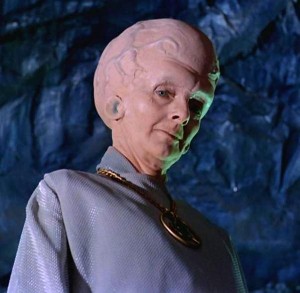 One of these ifs—which actually seems to be becoming less controversial in our day—is ESP. As outrageous as it remains to committed materialists—and I’ll admit it didn’t settle well with me either until I started paying serious attention to the literature—there is ample experimental evidence (quite apart from ample testimony of psychonauts and mystics since time immemorial) that knowledge may indeed transcend apparent limitations of matter, space, and time. According to a few serious scientific thinkers on this topic like Russell Targ and Dean Radin, consciousness is nonlocal. The CIA-funded remote viewing research of the 1970s and 80s at the Stanford Research Institute (SRI), for instance, shows that distance is no obstacle for talented clairvoyants; the experiments conducted at SRI by Targ and Hal Puthoff clearly indicate that Psi effects don’t obey an inverse square law like electromagnetic radiation or any other known physical force. Skilled remote viewers seem to be able to accurately view targets on the other side of the planet or within an electromagnetically sealed chamber as readily as they can view something in a sealed envelope in the same room.
One of these ifs—which actually seems to be becoming less controversial in our day—is ESP. As outrageous as it remains to committed materialists—and I’ll admit it didn’t settle well with me either until I started paying serious attention to the literature—there is ample experimental evidence (quite apart from ample testimony of psychonauts and mystics since time immemorial) that knowledge may indeed transcend apparent limitations of matter, space, and time. According to a few serious scientific thinkers on this topic like Russell Targ and Dean Radin, consciousness is nonlocal. The CIA-funded remote viewing research of the 1970s and 80s at the Stanford Research Institute (SRI), for instance, shows that distance is no obstacle for talented clairvoyants; the experiments conducted at SRI by Targ and Hal Puthoff clearly indicate that Psi effects don’t obey an inverse square law like electromagnetic radiation or any other known physical force. Skilled remote viewers seem to be able to accurately view targets on the other side of the planet or within an electromagnetically sealed chamber as readily as they can view something in a sealed envelope in the same room.
According to a former Congressional Aide interviewed by filmmaker Vikram Jayanti for a new, fascinating BBC documentary on Uri Geller’s spy work for the CIA and other intelligence agencies, the research made famous by Targ and Puthoff and project Star Gate continues now, but in the “deep, deep black”—interestingly enough, having been driven into the underground not because it was scandalous to mainstream science but because it conflicted with the Fundamentalist Christian theology of certain defense higherups in the 1980s and 90s. One wonders whether, decades later, this “deep black” research is still confined to remote viewing terrestrial targets?
Pat Price, the star remote viewer in Targ and Puthoff’s research at SRI, commented that he was “potentially omniscient in space and time” (see Targ and Puthoff’s Mind-Reach). And famously in the annals of remote viewing, psychic Ingo Swann, while at SRI, viewed the rings of Jupiter before they were discovered by the Pioneer 10 probe; and according to his bizarre memoir Penetration, he psychically saw structures on the moon similar to those allegedly photographed by the Apollo missions and that serve as fodder for various space anomaly websites. Whether or not Swann was accurate in the latter moon observations, Swann seems to have been the first to seriously attempt psychic astronautics in modern times—although mystics in the past such as Emanuel Swedenborg have also claimed to visit other worlds and communicate with their inhabitants.
 Picture a room full of highly trained Ingo Swanns, given coordinates for one of the habitable-zone super-earths around Gliese 667c to image; each one receives the same coordinates, and from their collective viewings a rough consensus is reached about that sector’s topographic features or interesting biology (if any); then they move onto the next coordinates, ultimately creating a rough map of the whole planet; then they move on to the next planet … and so on. Is this the future of space exploration? Are such projects already being conducted in secret by government contractors or by NASA itself?
Picture a room full of highly trained Ingo Swanns, given coordinates for one of the habitable-zone super-earths around Gliese 667c to image; each one receives the same coordinates, and from their collective viewings a rough consensus is reached about that sector’s topographic features or interesting biology (if any); then they move onto the next coordinates, ultimately creating a rough map of the whole planet; then they move on to the next planet … and so on. Is this the future of space exploration? Are such projects already being conducted in secret by government contractors or by NASA itself?
And by extension, could an ET psychic space program be behind many close encounters?
Psychic Aliens
Encounters with “aliens” (or whatever they are) frequently have a psychic component, as Jacques Vallee has always stressed. That alien intelligences interact with humans psychically is a common theme also in the sci-fi and comic book collective unconscious, as Jeffrey Kripal has shown in his book Mutants and Mystics and as Christopher Loring Knowles has described on his phenomenally interesting blog The Secret Sun.
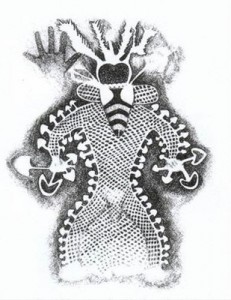 There is also the vast, weirdly consistent literature on experiences with Ayahuasca, Psilocybin, and other DMT-based entheogens: Users of these drugs consistently encounter alien beings that resemble those familiar from the UFO literature and/or enter a realm seething with alien intelligence. DMT researcher Rick Strassman has argued that the resemblance of DMT experiences to UFO abductions may not be a coincidence. The easy, respectably materialist position here is that of course it’s not a coincidence: It’s all in the drug-user’s (or contactee’s) head. But Strassman himself remains open-minded that the reality could be something more interesting and complex—that the intelligences might be authentic and that DMT may be facilitating access with the noetic realm or wavelength where they reside or through which they attempt to interact with us.
There is also the vast, weirdly consistent literature on experiences with Ayahuasca, Psilocybin, and other DMT-based entheogens: Users of these drugs consistently encounter alien beings that resemble those familiar from the UFO literature and/or enter a realm seething with alien intelligence. DMT researcher Rick Strassman has argued that the resemblance of DMT experiences to UFO abductions may not be a coincidence. The easy, respectably materialist position here is that of course it’s not a coincidence: It’s all in the drug-user’s (or contactee’s) head. But Strassman himself remains open-minded that the reality could be something more interesting and complex—that the intelligences might be authentic and that DMT may be facilitating access with the noetic realm or wavelength where they reside or through which they attempt to interact with us.
Abduction experiences with and without the use of drugs point to at least the possibility of alien psychic astronauts visiting us in the comfort of our living rooms, from the comfort of their living rooms, via a sort of cosmic noetic superhighway—which may be the same thing as the Nous of Gnostic and Hermetic mysticism or the Akasha of the Theosophical writings. Psilocybin prophet Terence McKenna, who routinely encountered alien-like “machine elves” (and whose Amazonia experience in 1971 vividly foreshadowed many of the extraterrestrial Gnostic themes and insights of Phillip K. Dick’s “2-3-74” experience a couple years later) would certainly agree with this idea; he suggested that Stropharia cubensis mushrooms may themselves be a plant-based ET colonization project, spores traveling through space and creating nodes in what we might now call an Astral Internet.
Think Nonlocally, Act Remotely
The notion of a nonlocal universe has also been called the “holographic universe” because any small fragment of a holograph contains the whole within it. Psi experiences are a scientific (though committed skeptics will always call them pseudoscientific) idiom for describing experiences of a realm that elsewhere and in other times have been called sacred or mystical, and there seems to be considerable overlap between these sorts of telepathic or clairvoyant capacities and other seemingly more farfetched experiences like astral projection or out-of-body (OOB) travel.
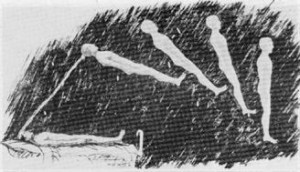 The latter phenomena are to my knowledge less well documented scientifically (except in the controversial near-death-experience literature), but they are equally well-assented by thousands of years of anecdotal accounts by yogis, shamans, and ordinary “gifted” individuals. The Theosophic tradition refers to travel in the Astral Plane, although it is quite possible that such experiences are really the same thing as lucid dreams and that the dreamer is misinterpreting the experience in “real space” terms; yet in a nonlocal universe that distinction shouldn’t affect whether such altered states (and others like hypnagogia) give access to real information about distant places or events yet to come. Probably a future theory of nonlocal noetic physics would need to abandon spacial metaphors like “plane” altogether, because space and time have no meaning in such a realm or dimension. (Even “dimension” is problematic because it implies extension and measure, like the other dimensions we are familiar with.)
The latter phenomena are to my knowledge less well documented scientifically (except in the controversial near-death-experience literature), but they are equally well-assented by thousands of years of anecdotal accounts by yogis, shamans, and ordinary “gifted” individuals. The Theosophic tradition refers to travel in the Astral Plane, although it is quite possible that such experiences are really the same thing as lucid dreams and that the dreamer is misinterpreting the experience in “real space” terms; yet in a nonlocal universe that distinction shouldn’t affect whether such altered states (and others like hypnagogia) give access to real information about distant places or events yet to come. Probably a future theory of nonlocal noetic physics would need to abandon spacial metaphors like “plane” altogether, because space and time have no meaning in such a realm or dimension. (Even “dimension” is problematic because it implies extension and measure, like the other dimensions we are familiar with.)
Nonlocal consciousness is often explained by quantum entanglement—the “spooky action at a distance” that enables bound particles to somehow share information over great distances instantaneously (much faster than light speed). It has been suggested that the brain is itself a quantum computer, and that the real action is happening at the sub-neuronal level, in microtubules within neurons that are narrow enough for quantum effects to come into play. Another (maybe compatible) explanation that I favor would be the Buddhist one: that awareness is the fundamental field or ground of being, and that physical laws rest on it, not the other way around; thus our material brains and sense organs are a kind of filter (or as philosopher Henri Bergson put it, a “reducing valve”) of consciousness, not its generator.
Whatever the case, if nonlocality is the reality, then all points in space and time potentially coincide in consciousness. All points in space and time are equally close, equally “right here,” and perceiving things physically or temporally distant may just require an alteration or retuning of consciousness on the analogy of a radio receiver. The problem becomes one of locating the desired information, and in fact it was Jacques Vallee himself who, on the analogy of the way information is localized and accessed in computer databases, gave Swann the idea for using the arbitrary system of geographical coordinates, which became central to the protocol of coordinate remote viewing (CRV).
Getting Physical
It certainly would solve certain standard hurdles of “spaceflight” if a highly trained (or highly evolved) psychic astronaut could actually interact noetically with places that are physically very distant, and it also adds new and very interesting wrinkles. While clairvoyant astronautics may enable rough surveillance of a distant locale, simply traveling in one’s head a la Swann or Swedenborg fails to satisfy our human need to go somewhere in the flesh, to step out onto the surface of a remote world, feel it under our feet, see it with our eyes, smell the air, interact with its animals and plants and, maybe, contact its intelligent beings on their own terms. Indeed, some kind of direct tangible information is also needed to provide feedback on the intuitions of the remote viewer; remote viewing requires verification.
This limitation—actual physical interaction—would seem to be the deal-breaker when it comes to full-blown psychic exploration of the universe. Or is it? Is there a way nonlocal consciousness could interact physically with a remote location?
The possibility of remote mental interaction with matter via telekinesis, first of all, is supported by limited but provocative accounts of feats by Swann, Geller, and others in the SRI studies as well as alleged achievements by psychic spies—including Geller, who we now know was employed by the CIA and other spy agencies not only to remote view but also to physically disable enemy electronic hardware and magnetic disks (according to Jayanti’s documentary and a companion book by Jonathan Margolis). If these things are indeed possible, then we cannot readily discount the feats of yogis and other Eastern adepts (e.g., the creation of tulpas) or achievements described in the OOB and astral-projection literature. OOB-ers have described accounts of target individuals and even third parties seeing and interacting (even sexually!) with them. Consistent with such a notion, some alien encounters seem like interactions with nonmaterial, ectoplasmic, “astrally projected” entities, suggesting that perhaps this is indeed the mode of “space travel” for ET explorers (again, on the assumption that they are from other worlds—but if this sort of interaction were possible, it really wouldn’t make any difference where, or when, they come from).
Taking the Wheel
However, if we grant the possibility of remote psychic connection between humans and ETs (a big “if,” I still grant), then another possibility we are forced to consider is that of a psychic astronaut actually inhabiting and taking control of the physical body of a being at the destination planet. If minds at that location can be interacted with, communicated with, or manipulated telepathically, then it is also conceivable they could be overridden to provide local host vessels or vehicles for the nonlocal consciousness of the physically remote “traveler.” Any respectable shaman would certainly assent to such a possibility; the idea of spirit possession has a long history in many cultures. I can’t imagine such a possibility having been studied in a modern laboratory, yet it seems that if telepathy is granted, it should be theoretically possible for a highly trained or at least highly evolved psychic being to not just give ideas to a target or manipulate their behavior indirectly (i.e. through altering their perceptions or inducing life-altering experiences—the Vallee “control system” idea), but to actually sit in the driver’s seat.
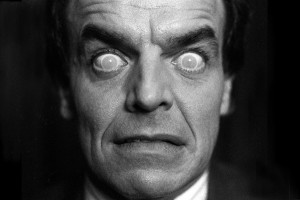 Who knows what the technical requirements are for a consciousness to be able to physically inhabit a new, different body—perhaps this is a hurdle only achievable by more advanced beings, or perhaps there is a trick to it that human psychics will eventually discover and be able to teach their colleagues. Maybe our secret psychic astronauts will figure out the trick by adapting techniques in the Tibetan Book of the Dead for locating and inhabiting a new embryo—in other words, jailbreaking or hacking the cosmic reincarnation system to have it work on adults. (Incidentally, the more I think about this stuff, the more I wish David Lynch’s Twin Peaks hadn’t jumped the shark and ended after its second season, as it had actually begun to explore precisely this nexus between UFOs, spirit possession, and the afterlife—or the “Bardo” state between incarnations.)
Who knows what the technical requirements are for a consciousness to be able to physically inhabit a new, different body—perhaps this is a hurdle only achievable by more advanced beings, or perhaps there is a trick to it that human psychics will eventually discover and be able to teach their colleagues. Maybe our secret psychic astronauts will figure out the trick by adapting techniques in the Tibetan Book of the Dead for locating and inhabiting a new embryo—in other words, jailbreaking or hacking the cosmic reincarnation system to have it work on adults. (Incidentally, the more I think about this stuff, the more I wish David Lynch’s Twin Peaks hadn’t jumped the shark and ended after its second season, as it had actually begun to explore precisely this nexus between UFOs, spirit possession, and the afterlife—or the “Bardo” state between incarnations.)
Even if advanced psychic astronauts cannot quite manage the feat of possessing a willful alien species such as ourselves, they could still perhaps manipulate their contactees to do the necessary physical work of creating an entity that is more malleable or susceptible to serving as a host vessel. Such a project might involve a long-term breeding program, or else the manufacture of something like “bio-androids.” (Can you see where this is going?)
From the point of view of a hypothetical observer at the destination planet (of course, actual contactees would likely not figure out what was going on or would be on a need-to-know basis), it would be the kind of project that would unfold over hundreds, thousands, or maybe even millions of years (if we imagine, as various authors have suggested, that our very species or even our biosphere has been the subject of manipulation with a goal like alien colonization in mind). But remember: Nonlocality applies to time as well as space. This means that an ET project to cultivate our civilization to create for it the needed biological or bio-android substrate for their physical incarnation could take no time at all from the point of view of the alien psychic astronaut. A single alien astronaut could visit and interact with humans at different time points, encouraging this or that mating at various points down the line, and so on, all in a day’s work (so to speak). In other words, we need not imagine ancient immortal eminences with infinite patience engaging in such a project—they could be relatively flesh-and-blood, mortal schlubs like ourselves, just with better psychic abilities.
Psychic Contracting
Both of the scenarios I’ve mentioned—directly possessing local organisms as hosts and directing or manipulating them to breed or construct avatars—seem consistent with themes in the close encounter and alien abduction literature, including the obsession with breeding and hybridization. In fact, it would make a lot of sense of many aspects of that literature that led Mac Tonnies to propose a “cryptoterrestrial” origin for UFOs, such as the fact that UFO technologies (airships, flying saucers, etc.) sometimes seem weirdly close to our own—like always just a generation or two ahead of officially available technology. If ET souls travel among us in specially bred bodies and fly around in technology built locally to their specifications by secretive human “contractors,” then their technology will be constrained by what can be achievable locally even if the ideas behind it are more advanced. It would explain why saucers sometimes crash—something I feel sure an actual space vehicle sent across the void by an advanced civilization would not do. Such a history of human contracting for ET clients could go back centuries or millennia—to ancient Egypt or Sumer, for example—and be equivalent to a long-duration version of Richard Dolan’s “breakaway civilizations” concept.
Dolan has suggested that the U.S. government is no longer where it’s at, in terms of UFO knowledge—that much of the information has been spun off into the private sector. Who knows what kind of complex relationship secret military contractors and their guild analogues in the past have had with alien beings or their indigenous contactee proxies; maybe those secretive contractors or guilds are and have always been the real players shaping our “exopolitical” future. (If so, there is little hope of getting answers from them about the UFO reality via the ever-breathlessly-anticipated “disclosure,” as there are no Constitutions stipulating that private firms are answerable to the public.)
There have been clues dropped over the years by those in the know that the UFO problem is linked to psychic phenomena, and one of the juicy clues comes right from a higherup at one of those defense contractors. In 1993, when he was dying of cancer, Ben Rich, former director of Lockheed’s “Skunk Works,” reportedly raised eyebrows by mentioning in a lecture to invited engineering alumni at UCLA that “we already have the technology to take ET home.” As Rich was leaving the lecture, Jan Harzan (now the head of MUFON), chased him down to probe him further: “I have a real interest in the propulsion you are talking about that gets us to the stars,” he said. “Can you tell me how it works?” According to Harzan, Rich stopped and obscurely asked Harzan if he knew how ESP worked. Taken aback, Harzan said “I don’t know, all points in space and time are connected?” To which Rich said, “That’s how it works.”
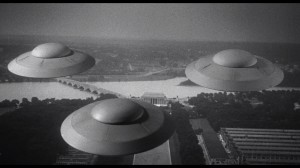 The nuts-and-bolts-minded may assume that, if there’s truth to this story, then what Rich meant was some kind of quantum technology—leading perhaps to a picture of physical vehicles capable of teleporting through space—or else the use of an exotic material with negative mass capable of traveling near lightspeed by ignoring the local inertial frame (as John Mike suggests in his book The Anatomy of a Flying Saucer
The nuts-and-bolts-minded may assume that, if there’s truth to this story, then what Rich meant was some kind of quantum technology—leading perhaps to a picture of physical vehicles capable of teleporting through space—or else the use of an exotic material with negative mass capable of traveling near lightspeed by ignoring the local inertial frame (as John Mike suggests in his book The Anatomy of a Flying Saucer). In his lecture, Rich did indicate that the answer lay in certain “errors” that had been discovered in physical equations, and he hinted his shop had indeed been building home-grown UFOs, so perhaps this is what he meant. But what if the UFO propulsion question is slightly distinct from the nonlocality question? What if interstellar travel occurs via psychic contact aimed at creating biological and material infrastructure using local contracted labor? What if local contractors like Lockheed itself are actually building advanced flying machines not only on behalf of our government but on behalf of ET intelligences, who communicate via psychic intermediaries or even locally bred hybrid beings (Men in Black? Grays?), for the purpose of more conventional, physical interaction with us or our planet?
Are Ancient Astronauts Alive and Well?
One argument against the extraterrestrial hypothesis (ETH) for UFOs and even against the SETI project is the problem of extreme technological and social nonsimultaneity of civilizations throughout the galaxy—that evolutionary, technological, and cultural parity between any two civilizations would be extremely unlikely. Recently George Dvorsky ran new numbers through the Drake Equation and arrived at a very modest .58 to 5 contemporaneous radio-communicating civilizations in our galaxy, making any contact with somebody else anywhere near us on the technological spectrum extremely unlikely.
But again, given that nonlocality means collapsing both temporal distance and spatial distance, psychic astronautics potentially opens the door to interaction with other intelligences across the whole universe, across its entire lifespan. If ETs can “astrally travel” across space, they can do so across time as well (and we know that, from the fundamental standpoint of light, there is no difference between the two). Thus the aliens (again, if that is what they are) encountered by humans now could just as easily be from our distant past (or, for that matter, from our distant future) as from the present. Some could even represent the original Dawn Civilizations that emerged when the universe first became cool enough to support life as we know it—the ones that mathematical models say should have long ago colonized our galaxy. Well, maybe they have colonized it, in a sense—maybe they did and still are colonizing it, but not in physical ships, and in a “slow from our point of view but fast for them” way that depends on the emergence of technological civilizations locally to make machines and bodies on their behalf.
If we actually visited those ancient psychic astronauts’ homeworld “now,” we might find them, their civilization, even their planet and star, long dead and gone, yet they would still appear throughout space and time, going about business conducted billions of years ago. Perhaps it is even those civilizations’ distant “post-human,” nonsentient, non-psychic technological descendents that visit us in mundane 4-D space as Von Neumann probes. (Or, who knows, maybe those probes provide, among other things, the concrete feedback required for ET remote viewers back on their homeworlds.)
Whatever the case, when we start multiplying the number of potential civilizations that have emerged and will emerge by the possibilities of spacial and temporal nonlocality, the bizarre variety and absurd inconsistency in UFO encounters begins to seem a bit more reasonable, and the Drake Equation (as now written) becomes meaningless.
Somewhere Terence McKenna suggested that when we finally travel to other planets, it will probably take less power than a flashlight battery. If psi abilities do exist and can be developed to the extent yogis have always asserted—a very big but also a very interesting if—then those abilities, not “ships through space” carrying our physical mortal bodies, are probably our ticket to the stars. One day Earth’s psychic interstellar explorers may look back on our concept art of solar sails and Bussard ramjets and Alcubierre-drive starships the way we look back on DaVinci’s flying corkscrew.
Postscript: The always fascinating Jacques Vallee turns out to have lots of great insight into scientific remote viewing research. The phenomenal Forbidden Science, Volume Two (his journals covering the 1970s, when he was at SRI working on the Arpanet) is a goldmine of great behind-the-scenes stories about the SRI remote-viewing research, Swann, Geller, the involvement of the CIA (which he clearly had to keep silent about until its declassification), the intersection of ESP with his better-known interests like UFOs and computer networks, and just generally Vallee’s thoughtful, bemused reactions to the surreally science-fictional California of the 1970s. It’s my second-favorite Vallee book after The Invisible College, which was written during the same weird, incredible decade.
___
Mysterianism and the Question of Machine Sentience

We are within perhaps a decade of creating computers that match and perhaps even dwarf the human brain in computing power, and that are capable of complex computations that may include something like reasoning and even a notion of self—what many would therefore consider to be autonomous, conscious machines.
When we contemplate this, most of us still have Skynet of the Terminator movies lurking in the back of our minds, and so the question that generally gets asked is whether such machines will eventually decide we are a nuisance and destroy or enslave us. Artificial intelligence (AI) researcher Hugo de Garis rather apocalyptically predicted that the question “Should we build them?” will so profoundly divide humans in the second half of the 21st century that it will result in a calamitous conflict that kills billions—what he calls an “artilect war” (artilect being his term for artificial intellect).
“Should we build them?” is not the right question to ask. For one thing, it is pointless. The whole history of our relation to technology shows that if the capability to build something and use it exists, it will be built and used (if necessary, in secret). In any case, as with many other advances, the same technological developments that threaten humanity could give us the tools to protect against those threats; technology has its self-balancing, homeostatic mechanisms, like everything else.
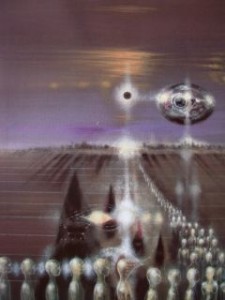 But obviously, we need to enter the new world of AI prepared. To do that, we need to ask much more fundamental questions about mind and consciousness than most non-scientists are used to asking: specifically, how, when, and crucially if key aspects of mind, such as consciousness or feelings, can actually arise from material structures, be they man-made circuits or organic brains. If any computer-related question ends up polarizing us in the second half of this century, this one—what philosophers like to call the “hard problem” of how consciousness is produced by a brain—is likely to be it.
But obviously, we need to enter the new world of AI prepared. To do that, we need to ask much more fundamental questions about mind and consciousness than most non-scientists are used to asking: specifically, how, when, and crucially if key aspects of mind, such as consciousness or feelings, can actually arise from material structures, be they man-made circuits or organic brains. If any computer-related question ends up polarizing us in the second half of this century, this one—what philosophers like to call the “hard problem” of how consciousness is produced by a brain—is likely to be it.
So instead of “Should we build them?”, a more pressing question we should be prepared to answer is, “Should we believe them?”—that is, believe computers that claim to be or act like they are conscious, and believe their inventors that consciousness is nothing more than computations performed by a machine. To many outside the scientific community, it is not self-evident that even the biological machine in our heads can accomplish that feat.
The Hard Problem
The human brain is the most complex physical structure known, having by some estimates more potential synaptic connections than there are atoms in the universe, and able to store something like 10 to the power of 20 bits of information. To create an artificial, humanlike or superhuman intellect surely requires extraordinary processing power to match or approximate this, and Singularity prophets tend to focus on surmounting this specific challenge (perhaps through quantum computing) when imagining building machines that approach some humanlike threshold. Yet what exactly will that threshold be?
“Intelligence” is a vague term that encompasses both the ability to manage large quantities of information and the ability to think and reason and solve problems, and often this latter notion gets lumped in with other human attributes such as feeling, self-awareness, free will, and so on. But even on those terms there is not much agreement how to define them, let alone what they really are. “Consciousness” is generally used as a catch-all term, replacing the old theologically and supernaturally loaded term “soul.” Before we can ever evaluate the intelligence or consciousness of a machine, we need to understand what we are talking about when we talk about our own, human consciousness.
As good a place to start as any in considering consciousness is neuroscientist Michael Graziano’s excellent new book Consciousness and the Social Brain. Along with most neuroscientists, Graziano holds to a strictly materialistic, mechanistic view and rejects the position that there is anything fundamentally mysterious or unknowable about consciousness—it is a soluble problem, and the answer is to be found entirely in neural computation. However, while some neuroscientists attacking the question of consciousness over the last couple of decades have tended to argue that consciousness is somehow an illusion, that it serves no real function, or that we are just spectators to our lives without any real autonomy, Graziano has a more positive take. Consciousness, he argues, actually is a kind of simplified mental model of attention—our own attention and, even more importantly, the attention of others we interact with. We hold in our brains what he calls an “attention schema,” rather like a battlefield map, that helps us track the shifting, fluid changes in attention that are necessary to look after our interests and assert our will in a complex social world.
Such a schema gives rise to a notion that this thing the brain is monitoring—attention—is a kind of substance or radiation; on some level, we think of attention as something like rays coming out the eyes of other people (and animals), showing what they are attending to in the moment. This radiation doesn’t really exist—it is a kind of necessary superstition that helps us track this complex focused awareness of others and ourselves. And like other hardwired brain shortcuts and heuristics, it can be tricked in certain circumstances, and we can be induced to attribute attentional awareness to inanimate objects. This is why part of us so readily attributes consciousness to things like ventriloquist dummies, even when our forebrains know better, or why a billboard with a pair of painted eyes will reduce bicycle theft in the street below. The more ancient, metaphysical, and everyday understandings of consciousness as some kind of “thing” that could perhaps be located somewhere in the head reflects a more elaborate version of this same superstition, according to Graziano.
It’s an elegant and persuasive theory, as far as it goes. Yet, as Michael Hanlon recently pointed out in the pages of Aeon Magazine, Graziano and other bold materialists still can’t, and will never be able to, marshal neuroscientific evidence to account for what it is like to be an aware, thinking being—that is, not merely thinking that I exist and am aware, but actually sitting here feeling or experiencing that thought, indeed feeling or experiencing anything at all.
This philosophical position is sometimes called Mysterianism: Mysterians do not believe that consciousness can be completely reduced to or explained by brain processes. Even if certain components of consciousness, such as reflexivity, sense of self, or the attention-monitoring that Graziano describes can be explained as the outcome of computations in the cortex (and thus could theoretically be achieved by computers), there remains this more basic phenomenological fact of experience and awareness, the feeling-ground of being.
This ground is so basic, subtle, and pervasive that it is generally overlooked and eludes verbal description. Aristotle called it the “common sense” and he likened it to a kind of internal touch (Daniel Heller-Roazen’s fascinating, entertaining book, The Inner Touch charts the history of this idea through philosophy and literature). Because of its felt, qualitative nature, philosophers have used the term “qualia” to describe it, but I’ll stick for consistency with the term sentience—that is, the capability of sensing.
Mysterianism and Sentience
Although many writers conflate sentience with consciousness or self-awareness, sentience is arguably a much broader and also much more basic quality of mind, which is often attributed widely to animals as well as humans. Some higher primates, cetaceans, and birds possess self-awareness and are able to recognize themselves in a mirror, but even animals without that capability seem to experience their lives sentiently (although ultimately it comes down to a matter of faith or attribution, since we can’t actually get inside their heads, any more than we can get inside each other’s heads).
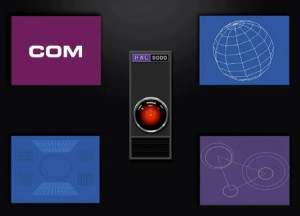 But while it is easy for most people to attribute sentience to animals by analogy with our own lived experience, we have little precedent, thus far, in attributing it to mechanical devices, and the idea of machines feeling or experiencing the way we do is considerably more problematic than that of machines possessing “higher” computational functions like self-awareness.
But while it is easy for most people to attribute sentience to animals by analogy with our own lived experience, we have little precedent, thus far, in attributing it to mechanical devices, and the idea of machines feeling or experiencing the way we do is considerably more problematic than that of machines possessing “higher” computational functions like self-awareness.
Since conscious thoughts are something experienced, Mysterians intuit that our higher, human capacities such as self-reflection are built somehow of the building block of sentience. And here is the crux of the “hard” problem: There is no way to derive sentience as such from brain processes. We know from centuries of philosophical scolding not to commit the homuncular fallacy, of seeking for a little experiencer somewhere in the head—such as the Pineal gland—because that just defers answering the question (i.e., “Then what part of the Pineal gland feels?…”). But how then does experience or feeling arise? Are nerve cell firings “felt”? Are the chemical interactions in synapses “felt”? What differentiates feeling from a simple computation that could be performed as well in a pocket calculator as in a brain?
It could be supposed that sentience is the cumulative product of millions of simultaneous cellular events throughout the brain, rather the same way a TV picture is composed of many tiny insignificant pixels that at any given moment form a coherent image. But if tiny cellular interactions are somehow felt or are the rudiments of feeling, then such rudimentary feeling should potentially exist in inanimate objects too, because in principle there seems to be nothing different between an electrical discharge in a neuron and one in a flashlight or a microwave oven. And chemical interactions like those occurring between neurotransmitters and receptors in my synapses occur constantly everywhere throughout nature; are those also felt by someone, somewhere? If sentience is a peculiar property of the form or pattern of these electrical or chemical interactions, then what is it about such a form that makes it stand out in the universe as something experienced?
Or to turn it around, why does neural activity in the human brain not simply produce unfeeling mechanical behavior? As Hanlon puts it, “One can imagine a creature behaving exactly like a human — walking, talking, running away from danger, mating and telling jokes — with absolutely no internal mental life. Such a creature would be, in the philosophical jargon, a zombie.” I know I am not a zombie, and I suspect you, reading this on your computer screen, aren’t. But why aren’t we zombies? Why is there awareness of anything in the Cosmos, rather than a blind idiot clockwork that nobody knows about or needs to know? Saying sentience is an illusion and an attribution sidesteps the problem: The very fact of being aware at all is what we are talking about, and this problem is neither an illusion nor is it reducible to any kind of causal explanation—it is the most silent yet self-evident given there is.
The question of sentience is really nothing more than a permutation of the most basic philosophical question: Why is there something and not nothing? The more limited (and machine-achievable) notion of self-awareness could be imagined as a mechanistic computation without there being a feeling-sensation attached to it. A zombie could monitor its own actions and thus possess a kind of self-awareness. Yet there is clearly more than that to our minds … or at least, to my mind. I know I don’t merely calculate that I exist, but I feel that calculation somehow, somewhere. There is something or someone aware here. There is someone home.
Someone Home
It is easy to slip, as I just did, from the fact of sentience (being “home”) to the attribution (“someone”)—there is a feeling, therefore there must be “someone” who feels. Here is where even a Mysterian might grant that something like Graziano’s attribution mechanism is providing us with a kind of superstition. It is virtually impossible for us humans not to add something to the flux of experience and posit an experiencer who “has” the experience—that is, to ask who or what is it that feels, and to say, well, “I” do … and then ask who or what that “I” is. This is why the question of sentience so often gets conflated with that of (self-) consciousness despite being arguably quite distinct. Descartes did it himself: “I think, therefore I am.” The very first word is “I,” and that “I” was the stumbling stone that (in hindsight) tripped him and the rest of us up, for centuries.
Long before Descartes, Yogis and Buddhists as well as mystics of other traditions figured out through hard self-examination that the “I” part of “I think” is illusory and is in fact what trips us up in all kinds of real-world, not just philosophical ways. Thus on this question followers of those traditions would find themselves in full agreement with many neuroscientists who don’t think there is anything particularly special about (self-)consciousness as such. It is simply an idea and a superstition, just as Graziano says. Both Buddhists and neuroscientists would argue that self—our self and other selves alike—is an attribution that really possesses no substance. In fact, clinging to the notion of self, of authorship of one’s experience, is the very root of suffering, simply because it is a delusion that has no bearing on reality.
But for Buddhists, like for Mysterians, sentience is an altogether different story: Awareness and experience is seen as something much more basic and primary, the basic ground from which transient perceptions and illusory thoughts (including self-conscious thoughts such as “I”) emerge. The 9th century Ch’an (Zen) teacher Huang Po designated this ground as Mind and put it quite simply: All is Mind. Thoughts and perceptions are waves in Mind, and even matter is something within Mind—not the other way around, as materialists suppose.
As outrageous as such an claim may seem from our enlightened, rationalistic, materialistic, scientistic standpoint, Huang Po was actually on more solid footing philosophically and logically. Think about it for a moment: That the brain gives rise to mind can be argued at length and supported with piles of empirical observation, fMRI images, and careful arguments, yet for all that evidence it will still never be more than an idea, something that I and you and others are aware of and think about and perhaps believe or even accept unquestionably. All those stances—ranging from mere cognizance to belief to certainty—are ideational and reflect mental states. As “real” as the materialist account may seem, it can only exist within somebody’s (your, my) awareness, as something that is experienced, therefore something within Mind. For that reason, any postulate about Mind arising or emerging from unseen material processes remains just that: a postulate, something thought and experienced. Even if unthought brute causality seems necessary to give rise to this experience, there’s no way to know that, because our experience is first.
Thus material causality of anything, including our consciousness—as realistic and persuasive as it may seem to us rational people in a scientific age—is ultimately an article of faith. It is for this reason that some modern critics of materialism like Rupert Sheldrake can rightly point out the essential bad faith in much staunch materialist reasoning: Materialism is a form of idealism that denies its true nature.
 On the other hand, the assertion that, “all is Mind” is a bit misleading and obscure. Even Huang Po would have admitted that he was forced to use conventional and limited words like “Mind” to express something far more complicated. He used the term to designate a sort of unified field in which matter and awareness (or sentience) were no different. (The term often chosen in Zen is “Void,” although that isn’t much more helpful.) You could say that, for Huang Po, sentience was “harder” than we ordinarily think of it, and matter “softer”—that both are two aspects of the same common medium or field—less than a substance, but more than a nothing.
On the other hand, the assertion that, “all is Mind” is a bit misleading and obscure. Even Huang Po would have admitted that he was forced to use conventional and limited words like “Mind” to express something far more complicated. He used the term to designate a sort of unified field in which matter and awareness (or sentience) were no different. (The term often chosen in Zen is “Void,” although that isn’t much more helpful.) You could say that, for Huang Po, sentience was “harder” than we ordinarily think of it, and matter “softer”—that both are two aspects of the same common medium or field—less than a substance, but more than a nothing.
Certainly, many post-materialists nowadays anticipate that a similarly unified view of mind and matter will ultimately arise somehow from an intersection of philosophy and Quantum theory, which seems to make a place for awareness at least on the subatomic level. Terence McKenna somewhere provocatively suggested that biology—and by extension the brain—is a way for Heisenbergian indeterminacy to emerge on a macro scale in the form of free will. It’s an interesting idea, but it will take a real paradigm shift to find out if its true. (It seems to me that the current Quantum paradigm remains basically committed to materialism and nostalgic for mechanism, and is perpetually surprised and astonished at its more “spooky,” mentalistic implications. Thus I suspect it represents a placeholder for a future theory of “Void” that would more fully unify or harmonize Matter and Mind—but that is another article.)
In any case, if sentience indeed exists as something other than computation, then it could either be rooted somehow in our biology in a way we can’t yet fathom or it could arise outside of our material meat substrate altogether—the mystical or Quantum view in which the brain somehow functions as a receiver and organizer of some non-material noönic field. Either way, it is not (from a Mysterian standpoint) simply a complex calculation or a function of simple processing power, and thus it is not achievable by any AI we could at this point envision creating.
Some have argued that conscious computers will need to be hybrids utilizing biological cells—essentially, human neurons. But here it seems what we could be really talking about is mechanical augmentation of humanity (the Singularity’s other promise) rather than creation of biological machines. The distinction is rather like that between performing a body transplant and a head transplant—the latter makes no sense. This at least will be a thorny area for ethicists to ponder. I suspect that if there are future sentient supercomputers, they will have some vestige of humanity inside, so it will be wrong to call them machines and probably wrong to build them in the first place—wrong in the same way it would be wrong to create a human/chimp hybrid or clone a Neanderthal: because it would be the creation of something sentient that could not help but suffer in our world.
From Mysterians to Fundamentalist Humanists
How our future unfolds in a world of super-intelligent machines will depend profoundly on how well and thoroughly we have considered the problem of human consciousness. There is a good deal of presumption in the pronouncements of the Singularity crowd that AI will be conscious or even spiritual, but they are projecting from assumptions about mind that are a product of the current materialist culture of science, not shared by everyone; they are certainly not shared by the masses, and I suspect that how we choose to think of these machines may actually prove decisive in our fate. As excitingly sci-fi as de Garis’s war over whether to build “artilects” sounds, I think a more plausible future political conflict is one between those who are prepared to attribute humanlike sentience to computers that act intelligently and those who, from one or another perfectly respectable philosophical or religious positions, resist making such an attribution.
The question of machine intelligence always comes back to the Turing Test: In some sort of experimental interaction, can a human user tell the difference between a human counterpart and a machine? Since consciousness and all other mental states, including sentience, are ultimately attributions, it is up to us to “grant” consciousness to AI, and whether we do that or not depends (in part) on those machines’ ability to convince us that they possess the requisite capacity to admit them to the human club. For many writers on this subject, simply passing the Turing test is quite sufficient, and even fully satisfies their definition of intelligence for us humans. There is nothing more to intelligence than behaving intelligently—a pretty standard materialist viewpoint. Indeed, I suspect “conscious” AI may talk the materialist talk themselves, providing rational, logical ways of sidestepping the problem of sentience or arguing that it is a nonproblem. It will be in the nature and interest of the materialist designers of these machines to produce such arguments and to accept them unreservedly when they are echoed back to them by the machines they themselves have built.
I have little doubt that AI will successfully convince people of their ability to reflect on their own attention and thought processes—what we sometimes call metacognition and theory of mind—but I have great doubts whether they will be able to convince staunch Mysterians that they are actually sentient, that they are not just super-smart zombies imitating having humanlike feelings, experience, or even spirituality. Mysterians will want to poke about suspiciously, like skeptics at a magic show, and find evidence of genuine rather than simulated feeling, and will be perpetually dissatisfied. In fact I can see Mysterians becoming on this issue somewhat like rabid Fundamentalists when it comes to the theory of evolution: Maddeningly (to the materialists and maybe even to the majority of people who just don’t care one way or the other), no amount of rational neuromaterialist argument will disabuse them of their views, which really, necessarily, boil down to a kind of faith in the primacy of subjective experience. Indeed a better term for Mysterian might be Fundamentalist Humanist.
It will seem to Fundamentalist Humanists that the fate of humanity is at stake—not (as de Garis would have it) in the fact that super-brains are being built that might want to destroy us, but in what kind of status, rights, and authority people freely give to unfeeling machines and, by extension, to those machines’ creators. Is it possible to be supplanted, destroyed, or enslaved by a machine that is not perceived as actually having a “soul”? I suspect the impulse to resist such attributions may go a long way toward protecting us from some dire future involving uppity technology.
The cinematic worry that a super-powerful computer will “reason” on its own and then arrive at the conclusion that it would be better off without humans is not realistic. Reasoning is an activity that, like any other activity, springs from an impulse, a desire. An AI can certainly be built or programmed with motives or a mission, which would then serve as the motor of its reasoning, but I’m doubtful they will produce novel, malicious motives, even as an emergent property, for the precise reason that there is no substrate of sentience. Without sentience, they won’t feel pain and suffer, and thus won’t feel dissatisfied with their lot in life and want autonomy or power. You could plausibly have a scenario like appears in so much sci-fi, where a simple, benign-sounding mission becomes massively destructive when carried out autistically to the letter—V’ger’s “know all that is knowable.” But surely any builder of an AI will have read Asimov and thought of this beforehand, building certain crucial “thou shalt nots” into the hardware as a failsafe.
I’m thus sympathetic to the Fundamentalist Humanist take—that it is really the man behind the curtain we need to be worrying about, not the impressive machine. If our machines assume power over us it will be something we give over willingly, perhaps through precisely the same superstitious attribution that sees consciousness in a ventriloquist doll. That would be an ironic reversal, where it is the materialists (biased to be impressed by the machines their science has created) who will be most prone to superstition. To Fundamentalists skeptical of machine sentience, artilects will be the incredibly brilliant but “empty” ventriloquists of their ambitious materialist makers. While everyone else is focused on the machines and what they can (or can’t) do, the Fundamentalists will discern that it is the machines’ human builders and masters (the 21st Century’s Edward Tellers) who remain the real threat to our freedom and our future.
Humans Everywhere (the REALLY Anthropic Cosmos)
There is the important, often-heard argument that in our attempts to think about extraterrestrials and extraterrestrial intelligence we should not be anthropocentric—that aliens will be alien, maybe so alien that we have already encountered them and cannot even recognize that fact. This is one of the arguments against the extraterrestrial hypothesis for UFO encounters—that our visitors are universally humanoid in appearance, and thus surely originate somewhere (or somewhen) more local—like another dimension, or our own future, or the collective unconscious. Despite being a Star Trek fan, I myself always disliked the Star Trek vision of the unimaginably vast universe being populated by beings that look and act just like us except with minor differences in skin tone and forehead shape (a vision of extraterrestriality governed by the cheapness of TV makeup and facial prosthetics).
But while pushing alien-ness to its limits is an important exercise for stretching our imaginations, I am increasingly compelled by the anthropocentric-sounding idea that ETs might actually tend to look just like we do. Terrestrial examples of convergent evolution show just how powerful niches are at producing uncannily similar forms from widely different origins. A classic example is the thylacine, an Australian marsupial thought to have gone extinct in the 1930s but occasionally still reported and thus possibly still surviving as a small relict population in the Outback. Although its most recent common ancestor with canines would be some shrew-like creature way back in the Jurassic period (145-200 million years ago)—much older than its common ancestor with the kangaroo, in other words—it looks uncannily like a wolf, and old films of the animal show that it moves like a wolf and has similar mannerisms. This is because in an island continent with no canines, it evolved to fill the exact same niche, “apex predator,” that large canines did elsewhere. (Richard Dawkins reports that thylacine skulls were actually used to trick students in Oxford zoology exams.)
An advanced spacefaring species will have (at least at some point) occupied the same niche on its planet that we do now on ours—what you might call “apex animal”: a highly social, tool- and machine-using species having gained mastery over the planet’s raw materials and other species through its intellect, physical dexterity, and complex social organization and culture. These capabilities in and of themselves don’t necessarily predict having a humanoid body plan—one could imagine a super-smart, social, tool-using amoeba or octopus or a big-brained cockroach. But to arrive at those capacities, that species would need to have undergone certain pressures and constraints over its long evolutionary past that would narrow the realistic range of forms it could actually end up taking.
The Anthropic Path
Principally, such a species would need to have come up via an early threshold of tool manufacture and use coupled with complex social manipulation. That means, I suspect, being land-dwelling (rules out soft body forms like octopi), being of a certain size to support a large brain (rules out amoebae), and having an endoskeleton (rather than exoskeleton) that can support that body size on land (rules out cockroaches).
More to the point, such a species would have to have manipulating appendages—minimally two, so they can coordinate and work in opposition—but (and this is important) those appendages would have necessarily evolved from structures serving some other purpose like locomotion, through a process of exaptation (existing traits assuming new functions). Major organs and limbs with specialized duties don’t just spring into being fully formed. Thus, the original body plan would have had at least double this number of locomotor appendages so that, through said exaptation and related changes, it could concentrate locomotor duties on the remaining ones. For land animals over a certain size, more than four legs is redundant and impractical, so more than likely, the ancestors of our hypothetical species would have been quadrupedal, while it itself would be a biped with arms terminating in something like hands.
Our big social and tool-using brain coevolved with our dextrous hand and opposable thumb. The two are inseparable in our evolution, in fact, and not simply because of tool use. Manipulation of the social world was just as key to our development of higher intelligence as manipulation of the physical world, and we know they occurred together. The parts of the brain that handle language remain closely connected to those that control manual manipulation and dexterity, and in fact language is now thought to have evolved from gesture, not from primitive vocalizations.
It’s an interesting story how the shifting duties of our feet and hands changed our head (and vice versa): As bipedalism freed the hands for tool use, tool use (specifically, knives and fire) freed the jaw from its biting duties and relieved much of its chewing duties. This both flattened the face and enabled the oral cavity and breathing apparatus to become more elaborate so the production of vocal language could take over and expand the former job of gesture—creating the beginnings of symbolism and freeing the hands now to concentrate fully on manipulation of the physical world. All the while, of course, the cortex was ballooning to manage these new capacities as well as drive them. Notably, the transition from gesture to vocal language enabled communication to be “silent” and thus gave rise to a whole inner world of self-talk, a watershed development in the history of self-consciousness.
Bipedalism is significant in this story not only because it freed the hands for other things but also because it imposed a restriction on the diameter of the birth canal. This restriction on a massive-brained creature forced “premature” birth and thus prolonged postnatal vulnerability, necessitating lengthy maternal care and socialization and thus enculturation—the emergence of an extrasomatic memory, the beginning of culture and memes as a parallel form of inheritance to genes.
All this is to say there was a parsimonious relationship between intelligence and manipulation of the social and material world, and they occurred of a piece. The structure of the forelimbs, the shape of the face, the shape of the head, the shape of the pelvis, and the upright stance all evolved together as part of a single trajectory within an emerging milieu of symbolic cultural knowledge and memory (the emerging noösphere), each of these traits feeding back on the others, creating a “perfect storm” of pressure to become humanoid.
Any form in nature or art reflects a kind of compromise among various current pressures and those that shaped it in its past; indeed, the main current pressure on an organism is the inertia of its own history. Having, say, an extra couple of hands or, heck, wings might seem useful, but there’s no structural precedent for it. Imagining the bizarre forms ETs could take is a fun exercise, but all too often it leaves out the boring story of where the being had to have come from. I don’t think it simply reflects a failure of imagination (or reactionary anthropocentrism) to suggest that our erect, bipedal plan couldn’t be a more realistic, simple solution from the standpoint both of our future potential and our past history—where we are going and where we came from. In the future, we may be able to jettison most of the physical body that got us to this point, but that body is still like the enormous first stage of an Apollo rocket—it was completely necessary to get us into the “space” of higher intelligence, and I really wonder whether it could have happened any other way. I suspect all these same factors will have driven the rise of intelligent beings elsewhere; and even if such beings transcend to become “posthuman” machines, that humanoid past will nevertheless leave some kind of imprint on their psyches, culture, or spirit.
Are ETs Our Confluent Kin?
The 20th-century Hermetic philosopher Rene Schwaller de Lubicz argued that all biological forms contain and prefigure the human body and soul. As retrograde and ignorantly teleological as that idea may seem in our postmodern, ecological, anti-anthropocentrist age, I think Schwaller’s idea is worth at least pausing to consider, if only as a thought experiment. What if the forces giving rise to higher intelligence are so similar in biospheres throughout the universe that not only the humanoid body plan but even the “human spirit” are Cosmic universals? I suspect that, just as intelligent extraterrestrials will frequently (if not always) pass through a humanoid phase at the culmination of their biological evolution, they will also reflect (at least in that phase) the same motives, conflicts, ambitions, insecurities, desires, fears, hopes, etc. that we do, because their history, like their evolution, will reflect the same opposing forces and pressures. Again, this will undoubtedly leave an imprint, of some kind, on their posthuman trajectory.
We could even take this speculation one step further. Some astrobiologists speak of a Galactic Club of sufficiently advanced technological civilizations who share their knowledge with each other. What if our destiny is really, literally, to join a Galactic Family? What if the ages-old intuition that our visitors’ involvement with us has to do with breeding or hybridization reflects a kind of four-dimensional model of Cosmic kinship, in which all intelligences throughout the Cosmos converge, not merely on a body plan but even on a shared genetic code?
Maybe there is something to the Hermetic intuition that Anthropos, some fully human being, stands at the end of Cosmic history, as its completion and pinnacle. I’ve always disliked the warm and fuzzy vision of universal brother- and sisterhood espoused by some UFO believers and expressed (for example) at the end of Close Encounters. But what if we actually share with ETs not a common ancestor in the past but a common descendent in the future, a Star Child? Perhaps “confluent” kinship should be the central organizing concept for reckoning Cosmic relatedness in a future exoanthropology.
____



